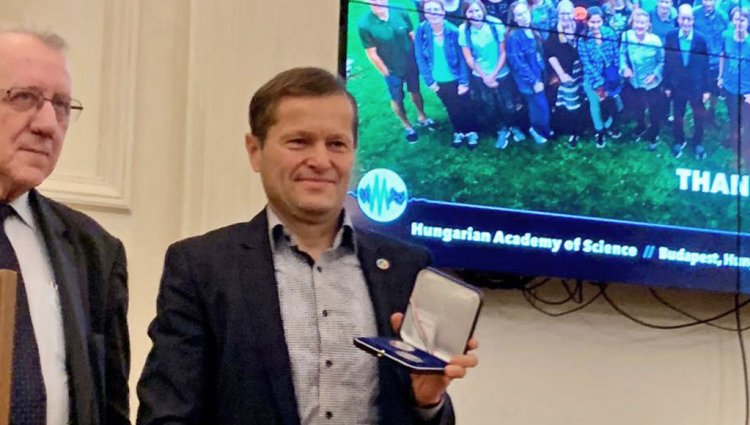News
Become our partner
To achieve our goals, we are continuously expanding our strategic cooperation network with partners in the Hungarian healthcare service sector.
Our company is looking for partners to carry out large-scale medical research involving blood sample collection:
- Personal and material preconditions: medical and assistant staff, National Center for Public Health and Pharmacy (NCPHP) license for blood sampling activities; medical testing, blood sampling, processing, and special storage conditions for the implementation of an approved study protocol
- Inclusion potential, capacity: the ability to recruit approximately 200 high-risk but healthy volunteers from a self-selected population in one year to conduct follow-up visits of recruited subjects, initially monthly and then annually, with a minimum of 5 years of follow-up with a low attrition rate
- Primary criteria for subjects (a subject is eligible if it meets all of the following criteria)
- Over 50 years old;
- Taking medication for hypertension;
- Having high cholesterol or taking cholesterol-lowering medication;
- Active smoker or having a significant smoking history;
- Feeling healthy and having no other severe medical conditions;
- Experience: proven experience of several years in successfully conducting a large number of clinical trials/medical research
If you meet the above criteria, please get in touch with our company at info@cmf.hu.
Health, Artificial Intelligence, and a Dinosaur egg
The latest issue of attoworld´s magazine “pulse” is available both as a printed version and online as a PDF.
Many former members of the attoworld-team have contributed to this publication. The issue is dedicated to the Nobel Prize for Physics, which Ferenc Krausz received last year. However, there are also exciting articles on topics from the fields of medicine and artificial intelligence. For example, Mihaela Žigman asks in her feature article, what health means. Vasileios Papalampropoulos discusses how artificial intelligence can influence our lives. And anyone who would like to take a look inside a dinosaur egg will also find what they are looking for in the new pulse.
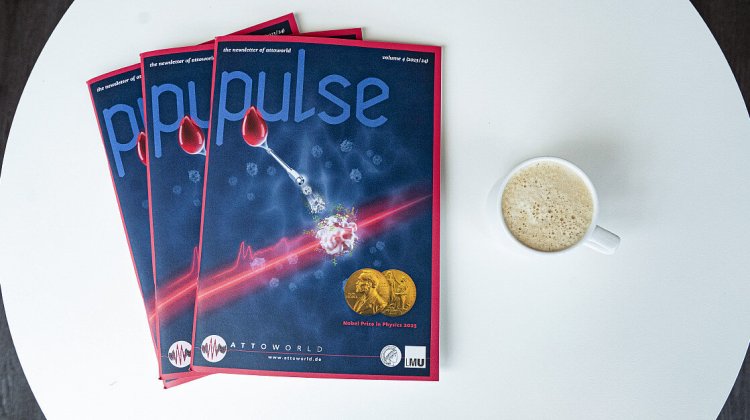
Waves, the magazine of CMF
The first issue of Waves, the magazine of CMF, is published and presents the work and aims of our Research Center. You can learn more about CMF's clinical research and the H4H Program, as well as the role of data science in infrared molecular fingerprinting.
You will also find interesting information about laser physics, attosecond, and the storage of biological samples. Learn more about our work, collaborating scientific fields, and the interdisciplinary team. You can read the online version here.
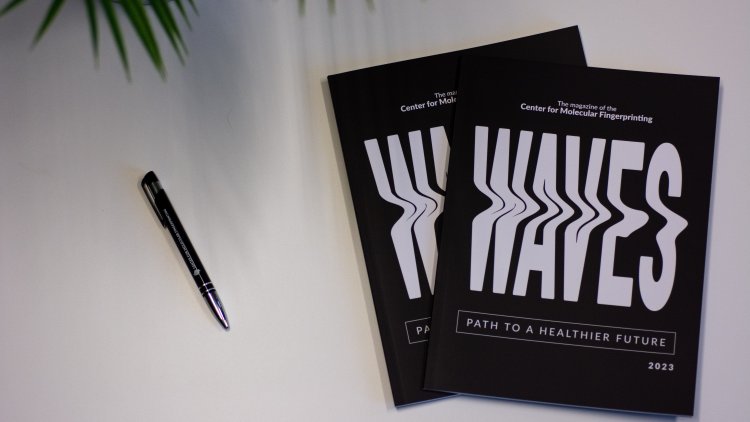
Molecular spectroscopy zooms in on blood plasma protein modifications
Infrared spectroscopy of blood plasma has the potential to become an experimentally simple and inexpensive way to profile the health status of an individual. However, the amount of clinical information that can be gained through infrared spectroscopy is largely limited by the between-person variability and overall molecular complexity of blood plasma.
In their latest study just published in Analytical Chemistry, the Broadband Infrared Diagnostics team (BIRD), led by CMF Research Director Dr. Mihaela Žigman, steps towards circumventing both obstacles. On the one hand, the group narrowed the focus to one molecular class – blood plasma protein glycosylation. Changes in this post-translational modification are known to accompany virtually any biological process in the body, including multiple diseases. Thus, the results and conclusions are of immediate relevance to biomedical research.
On the other hand, the scientists separated blood plasma proteins into individual fractions of lower molecular complexity, which can now be analysed individually. Furthermore, in collaboration with the Bavarian Center for Biomolecular Mass Spectrometry and Genos Ltd., the team thoroughly characterised the fractions using mass-spectrometry based proteomics and glycomics. Overall, this work capitalizes on the benefits of infrared molecular fingerprinting but uses a specific sample preparation approach to increase the amount of obtained spectral information and its interpretability, potentially leading to improved disease detection.
The publication is featured on a supplementary cover in the magazine.
Original publication: probing blood plasma protein glycosylation with infrared spectroscopy
L. Voronina, F. Fleischmann, J. Šimunović, C. Ludwig, M. Novokmet & M. Žigman
Analytical Chemistry, February 07, 2024
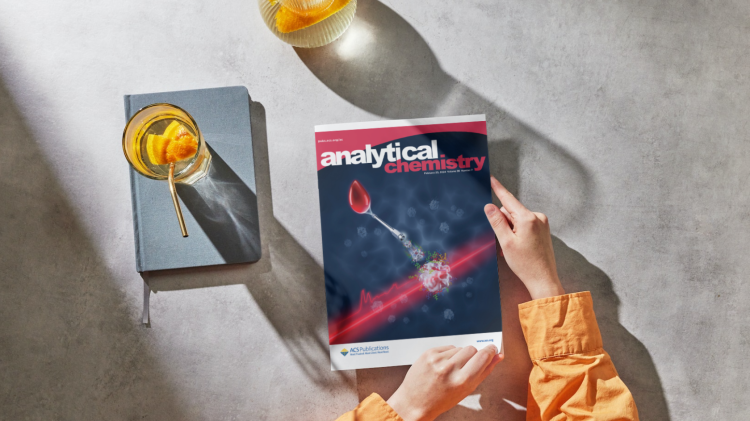
Ferenc Krausz receives the “Maximiliansorden of Bavaria”
Ferenc Krausz has received the prestigious “Maximiliansorden”. With this award, the Free State of Bavaria honours his pioneering work in the field of Attosecond physics. Prime Minister Markus Söder presented the “Maximiliansorden” in person at the Bavarian State Chancellery.
The Maximilian Medal for Science and Art, which Markus Söder described in his speech as the “Nobel Prize in white and blue”, is the highest state honour that researchers and artists can receive in Bavaria: “It is a prize that you cannot buy or inherit, but that you have to earn,” Söder explained at the award ceremony.
“I would like to thank you very much for this award. It is a great honour to be included among the illustrious recipients of this medal,” explained Ferenc Krausz in his acceptance speech, “and I would also like to thank the excellent research conditions in Bavaria.”
The Bavarian Maximiliansorden was originally founded by King Maximilian II of Bavaria. It has existed in its current form since 1980, and the number of living recipients is limited by law to 100. In addition to Ferenc Krausz, the MPQ directors Immanuel Bloch and Theodor Hänsch have also received this high honour.
Following the award ceremony, Ferenc Krausz participated in the Cabinet meeting: “Today we had one of the world’s brightest people as a guest in the Cabinet. His Nobel Prize is a task and an incentive for Bavaria so that we can continue to offer the best conditions for the best research with our high-tech agenda,” reads the official statement by Minister President Markus Söder.
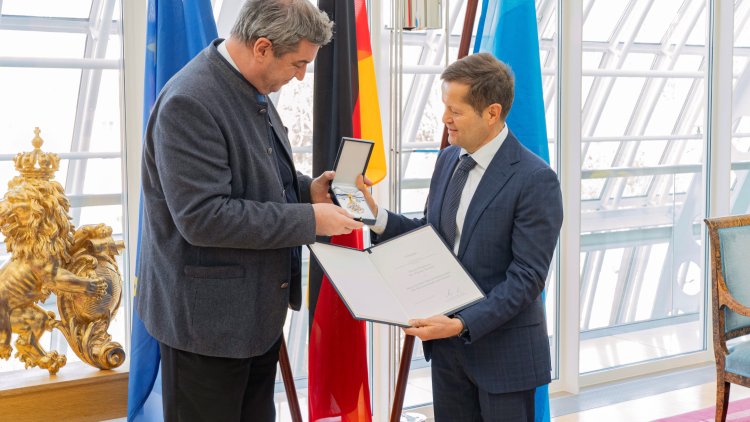
Nobel Prize awarded to Ferenc Krausz
Ferenc Krausz received the Nobel Prize in Physics from Sweden's King Carl XVI Gustaf on Sunday afternoon. The scientist was honored at the Stockholm Concert Hall together with his co-laureates in physics, Pierre Agostini and Anne L'Huillier. The attosecond physics they developed "enables us to answer fundamental questions," it was said at the presentation of the physics laureates.
The festive ceremony with around 1500 invited guests was opened with the entry of the royal family - King Carl XVI Gustaf and Queen Silvia as well as Crown Princess Victoria and Prince Daniel - and the Swedish royal song "Kungssången." In her opening speech, Astrid Söderbergh Widding, Chairwoman of the Nobel Foundation, recalled the conviction of prize founder Alfred Nobel, who "believed in the unique power of science, literature, and peace initiatives to change the world for the good of mankind." The CMF team is proud and congratulates Ferenc from the bottom of its heart!
You can follow the entire award ceremony here.
The previous Friday, Ferenc Krausz had given his Nobel Lecture in the Aula Magna of Stockholm University. In it, he described the development and research of attosecond physics from his perspective and gave an outlook on the areas of application in the field of preventive healthcare, which has been ongoing for several years in cooperation with the Center for Molecular Fingerprinting in Garching and Budapest.
The Nobel Lecture by Ferenc Krausz is available here. His speech starts at 1:19:00.
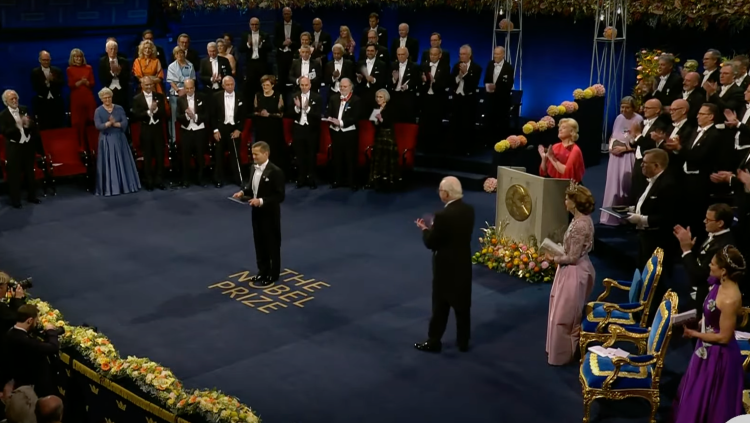
Nobel Week 2023
The Nobel Week will take place in Stockholm and Oslo from December 6 to 12, 2023, where we celebrate the 2023 Nobel laureates and their work.
Most events will be available to watch live on the Nobel Prize's official YouTube channel. More information about the streams during Nobel Week can be found here.
During this week, the laureates will give lectures on their discoveries and the history and background of their award-winning work.
We would like to proudly point out that the Nobel Prize lecture in Physics by Ferenc Krausz, "attosecond physics: exploring sub-atomic motions," together with the presentations by Anne L'Huillier and Pierre Agostini, will take place on Friday, December 8, from 9 am.
Nobel Prize lectures in physics
Location: Aula Magna, Stockholm University (registration is required)
09:00-10:55 CET
The lecture will be streamed live and can be accessed here.
In line with tradition, the Nobel Prize ceremony will be held on December 10, the anniversary of Alfred Nobel's death. The Award ceremony in Sweden at the Konserthuset Stockholm (Stockholm Concert Hall) will take place on Sunday, December 10, at 16:00 CET, where Dr. Ferenc Krausz, Pierre Agostini, and Anne L'Huillier will receive the 2023 Nobel Prize in Physics "for experimental methods that generate attosecond pulses of light for the study of electro dynamics in matter."
It can be followed live here.
We wish Ferenc the very best and look forward to the events!
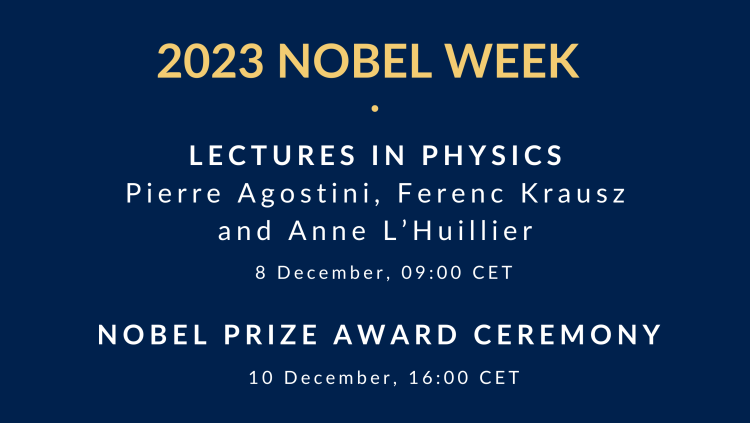
Live Lecture from Wroclaw Tech
Prof. Ferenc Krausz, winner of this year's Nobel Prize in physics, will come to Wroclaw Tech. The visit is related to the opening of a research group cooperating with the scientist at the university. The Nobel laureate will also give an open lecture as part of the Interdisciplinary Science Seminar.
The visit of the scientist cooperating with Wroclaw Tech University is connected with the inauguration, scheduled for Tuesday, November 7, of a special research group specializing in the construction of ultrafast lasers. Its head is Maciej Kowalczyk, PhD (Faculty of Electronics, Photonics, and Microsystems), who collaborated with Prof. Krausz in Germany on a postdoctoral fellowship in 2020-22.
"We have been selected to participate in the prestigious Max Planck Partner Group program," explains Maciej Kowalczyk, PhD. " It is funded by the Max Planck Society, which will provide a grant of €100,000 for the group's activities at PWr", he adds.
On the same day, the Hungarian scientist will also give an open lecture at Wroclaw Tech on "Attosecond Science: From accelerating electronics to studying human health." The lecture will be part of the Interdisciplinary Science Seminar and will focus on light pulses on the attosecond scale and their application in medicine.
Those wishing to attend are invited to the auditorium in Building D-20 on Tuesday, November 7 - beginning at 1:15 p.m. Admission is free, but advance seat reservations are required. The live broadcast of the lecture will also be available on YouTube.
Wykład tegorocznego noblisty - prof. Ferenc Krausz na PWr - YouTube
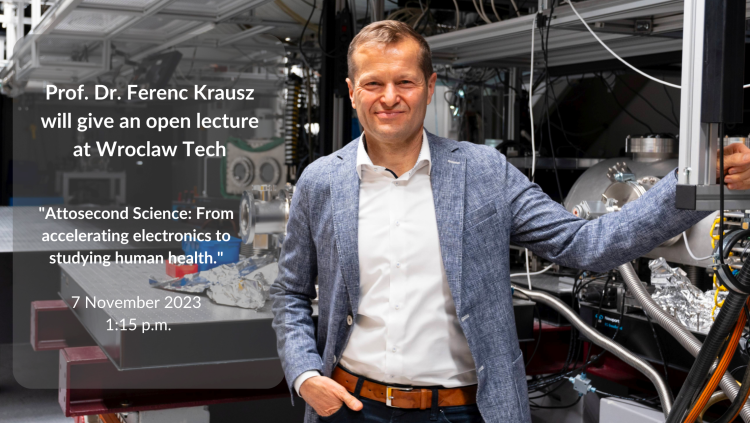
We are Nobel Prize!
"I would like to take this opportunity to express my heartfelt gratitude to all my colleagues as well as former companions for their great commitment, phenomenal support, and strength to endure over the years on the scientific path we have taken. The gratitude extends beyond those directly involved in research. Without the bright people and helping hands in technical problems, administration, communication and management, we would not find ourselves where we are today.
This year's Nobel Prize was awarded for attosecond physics, a field of research that has made it possible to detect the fastest motions outside an atomic nucleus, the motion of electrons. The prestigious award thus honors, first and foremost, the many years of effort in the field of basic research, which contributes to a better understanding of the physical processes in our world.
However, the findings we gain from our ability to capture electronic motions and light waves should not be the sole preserve of research in its so-called ivory towers. The knowledge accumulating from basic research should always be the starting point for the conception and development of helpful and highly needed applications in order to let humankind benefit from resource-intensive basic research.
Formula 1 motor racing may seem useless and wasteful to some people who see it as little more than drivers going around a circuit at speed. However, their innovative excellence and safety regulations are gradually being incorporated into the development of our everyday vehicles. With attosecond physics, we have created a "racing car" that is a trillion times faster than a Formula 1 model. And we do not wish to use this technical capability to move in circles. Rather, we have envisioned that attosecond technology may – one day – enable us to create diagnostic instruments that will capture minuscule changes in the molecular composition of blood plasma and provide early alerts about emerging chronic diseases. By doing so, it will – as a cornerstone of future preventive healthcare – contribute to protecting human health and saving lives. We started this endeavor several years ago in our Center for Molecular Fingerprinting (CMF), in close cooperation with the Ludwig-Maximilian's Universität. With our dedicated and trusted teams in Budapest, Szeged, and Munich, we continue the pursuit of this grand goal with utmost commitment. To the benefit of future generations."
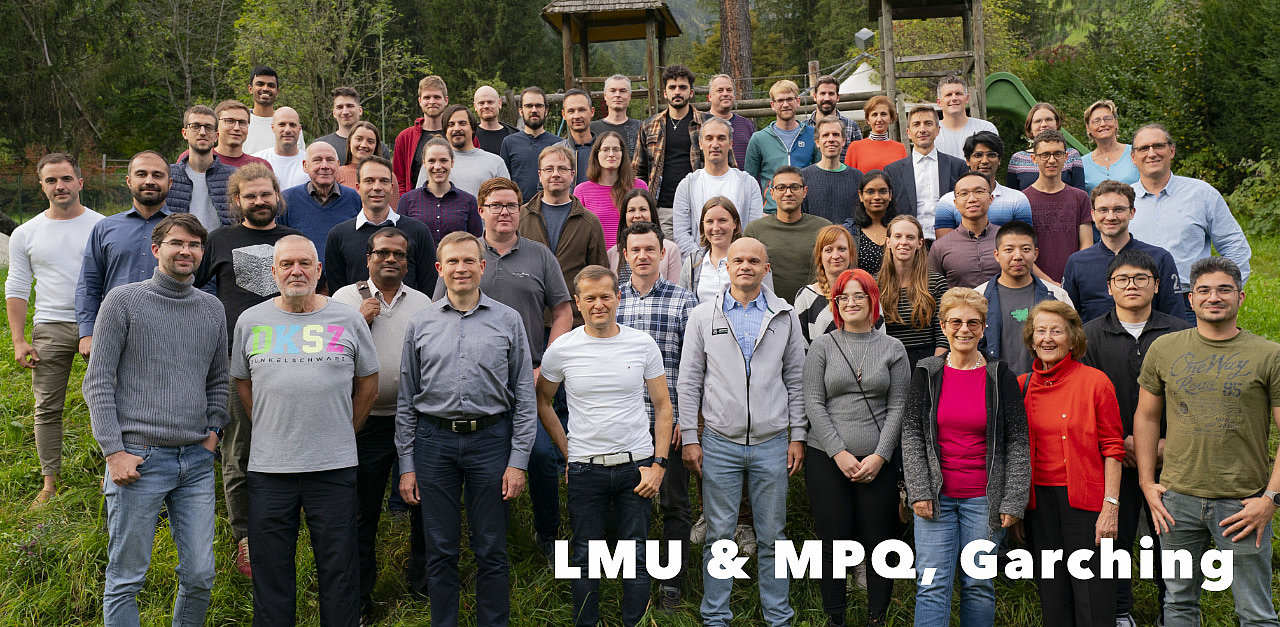
Ferenc Krausz
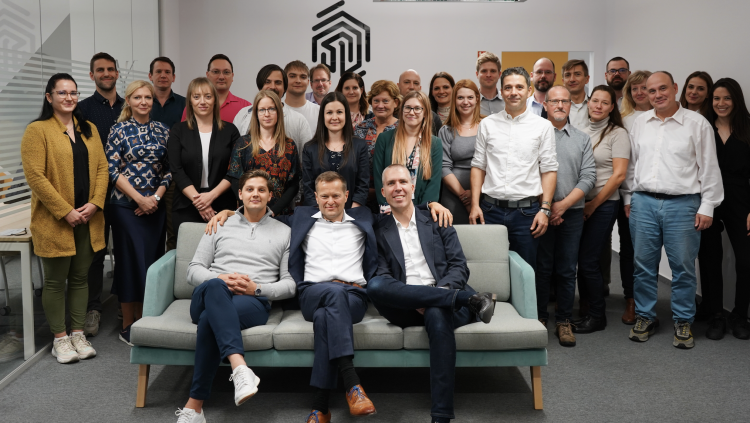
Congratulations to Prof. Dr. Ferenc Krausz, CEO of CMF, for the 2023 Nobel Prize in Physics!
The 2023 Nobel Prize in Physics has been awarded to Ferenc Krausz, Pierre Agostini, and Anne L’Huillier “for experimental methods that generate attosecond pulses of light for the study of electro dynamics in matter”, The Royal Swedish Academy of Science announced on October 3, 2023.
The three Nobel Laureates in Physics 2023 are being recognised for their experiments, which have given humanity new tools for exploring the world of electrons inside atoms and molecules. Ferenc Krausz, Pierre Agostini and Anne L’Huillier have demonstrated a way to create extremely short pulses of light that can be used to measure the rapid processes in which electrons move or change energy.
Photo credit: Ill. Niklas Elmehed © Nobel Prize Outreach
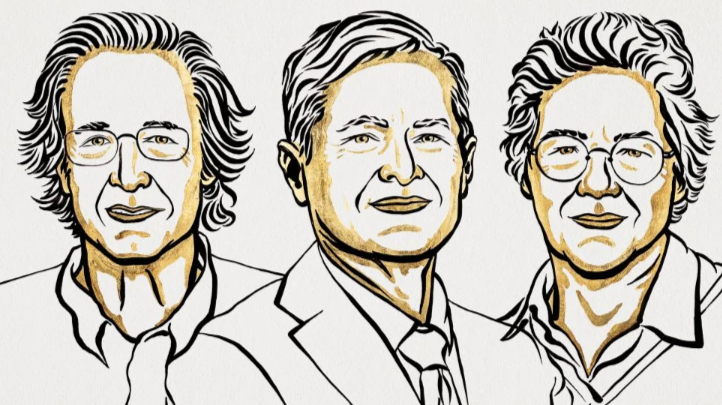
Ferenc Krausz at Wigner 121 Scientific Symposium
CMF is pleased to announce that its Scientific Director, Prof. Ferenc Krausz will give a lecture at the Wigner 121 Scientific Symposium in Budapest, themed "Heritage and Future". The scientific conference will take place from 18.9. to 20.9. 2023 at the Grand & Thermal Margaret Island Hotel in Hungary's capital.
Ferenc Krausz will present his talk on "Attosecond science - future directions" at 11:40 a.m. on Monday, Sept. 18. He will inform about the basic research on ultrashort pulse physics and its promising application in the field of medicine for early detection of diseases, which he is exploring with the Center for Molecular Fingerprinting (CMF).
With the "Wigner 121 Scientific Symposium," the Wigner Research Center for Physics celebrates the 121st anniversary of the birth of its namesake and the 10th birthday of the research center. On the one hand, it is a tribute to the scientific legacy of Eugene Paul Wigner, who received his Nobel Prize 60 years ago. On the other hand, it is an international forum where the scientific community of Wigner RCP, the institute that bears Wigner's name, will present the latest scientific achievements of the institute.
For more information, please see: Wigner 121 Scientific Symposiun (18-20. September 2023)
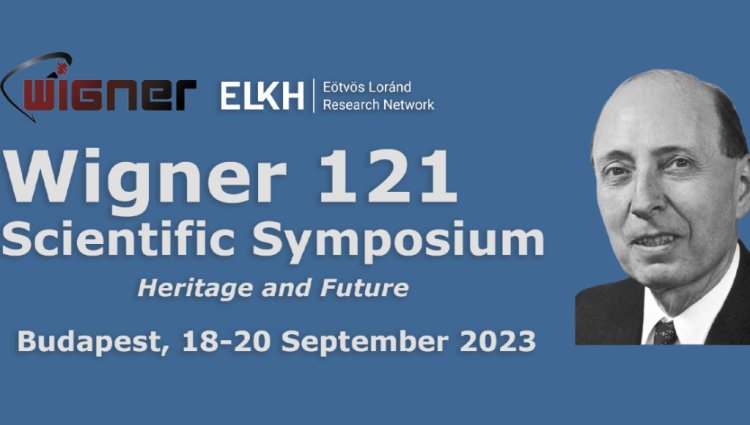
Ferenc Krausz at Nobel Symposium 172
CMF is pleased to announce that our Scientific Director, Prof. Ferenc Krausz, will be honored to speak at this year's Nobel Symposium on Attosecond Physics and Technology.
This international conference at the highest scientific level is scheduled to occur in Båstad, Sweden, August 20-24, 2023. Ferenc Krausz will give his talk, "Attosecond science: (some) future directions," as the grand finale of the convention in the afternoon session on Wednesday, August 23, from 4:25 to 4:55 p.m. in the conference hall of the Skansen Hotel. In it, he is to describe the basic research and history of attosecond science, much of which is based on his and his team's results, and give a fascinating outlook on the concrete applications, especially in the field of early detection of diseases.
Since their inception in 1965, the Nobel Symposia have been proposed by the Swedish academic community and funded by the Royal Swedish Academy of Sciences after approval by the Programme Committee of the Nobel Foundation.
The conference program and further information you can find here:
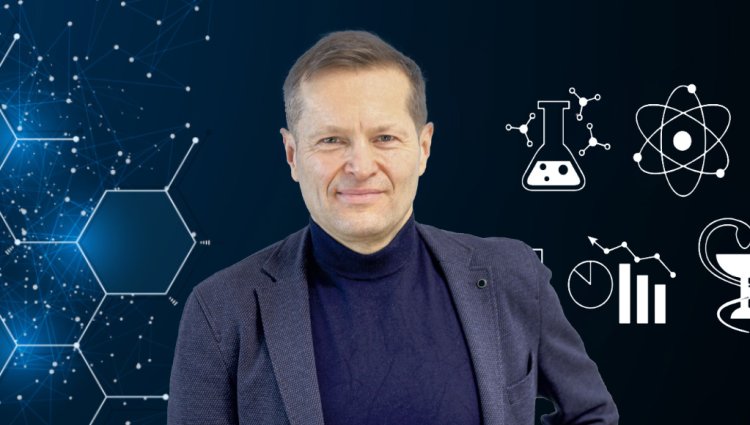
Frontiers of Knowledge Award for Ferenc Krausz
On June 20, 2023, the BBVA Foundation's "Frontiers of Knowledge Awards" were formally presented for the 15th time in Bilbao. Ferenc Krausz received the honor in the category "Basic Research" in the field of physics with his deserving colleagues Anne L'Huillier and Paul Corkum as pioneers in attosecond physics.
Their research has made it possible to observe subatomic processes occurring in the shortest time span that science can record. In his acceptance speech, Ferenc Krausz thanked the BBVA Foundation for honoring and recognizing the results of his research, his family, and all those who supported him and his scientific team and collaborators for their joint success.
Krausz was keen to emphasize that science is always a shared and constant intergenerational process. This is how he literally puts it: "This award serves as an encouragement to scientists around the world to strive to push the boundaries of knowledge. (…) Finally, I would like to dedicate this award to the countless scientists and researchers whose pioneering work has provided the foundation upon which we stand today."
He also announced that he would donate half of the prize money to Science4People, an initiative that he and some of his team members had set up to support the education of children and young people in crisis areas, as is currently the case in Ukraine.
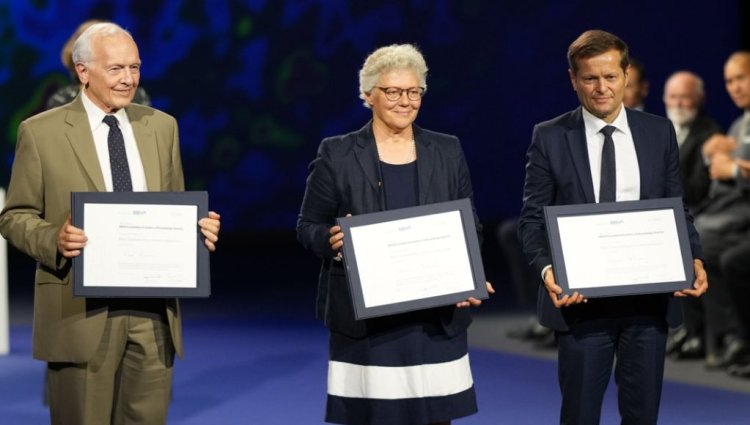
Fingerprinting study “Lasers4Life” in Munich now enrolling participants!
We are pleased to announce that our close collaborators at the LMU (https://www.attoworld.de/bird.html) successfully reactivated the clinical study "Molecular Fingerprinting for Cancer Detection". CMF will perform the audit to help make sure that all procedures are according to the protocol. This collaboration also means that CMF, which runs a similar study in Hungary, will be able to use the results of this study for their analysis.
Excitingly, the enrolment has started at LMU Hospital just recently! The Broadband Infrared Diagnostics (BIRD) group's clinical study team has achieved this significant milestone after months of preparation and planning. Going forward, the study nurses will be actively searching for individuals at the clinic to participate in the study. Using electric-field molecular spectroscopy, the ultimate goal here is to develop a medical device to complement current primary cancer diagnostics, which unfortunately still have limitations.
Over the next few years, the plan is to enrol thousands of individuals with different types of cancer, as well as control individuals, initially at LMU Hospital in Munich and later at other clinics in Germany. Participating in the study is simple and only requires a small blood donation and filling out a short questionnaire. The BIRD team will process and measure the blood-based samples using infrared spectroscopy at the laser labs of the Ludwig Maximilian University (LMU) in Garching.
Using machine learning algorithms, the BIRD team will evaluate the spectral data, the so called "fingerprints", to search for cancerous patterns. Delving deeper, we are uncovering ever increasing complexity at the organismal, cellular, and molecular levels. Plus, even when symptoms become noticeable, they often mimic non-cancerous diseases. Simply put, detecting cancer at its earliest stages presents great challenges. However, the more data there are available, the better our chances are of success.
Despite these challenges, already obtained encouraging results lead us believe to be on a viable path towards improving cancer detection!
Reference:
The Lasers4Life clinical study is registered and can be viewed at the German Register of Clinical Studies (https://drks.de/search/de/trial/DRKS00019844). For more information, please visit the website https://www.lasers4life.de/.
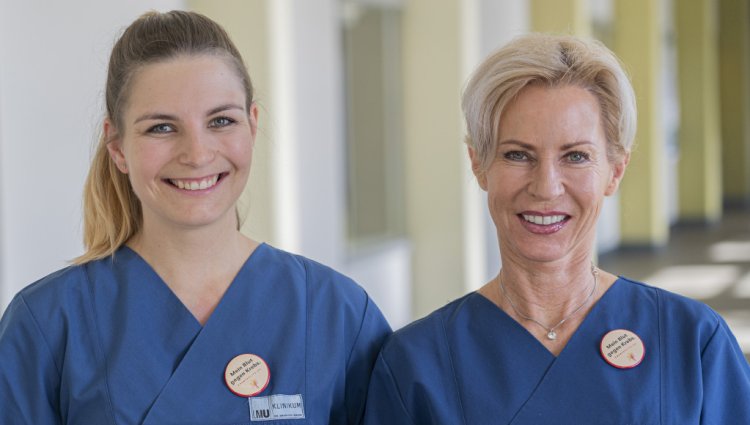
Dr. Kosmas Kepesidis joins CMF as Chief Data Scientist
CMF is sincerely pleased to welcome Dr. Kosmas Kepesidis as Chief Data Scientist and Head of our Data Science Division, effective March 1, 2023. Kosmas has been cooperating closely with Dr. Mihaela Žigman for the last few years and will continue to work for CMF from the Garching office.
Kosmas holds a Ph.D. in Theoretical Physics from the Technical University of Vienna and also studied at the Universities of Crete and Munich. He also specialized in Data Science at the Ludwig-Maximilians-University in Munich. Kosmas has a wealth of professional experience in both research and industry and has been part of our Attoworld and LMU research projects during the last few years. His research responsibilities involved the application of statistical and machine-learning methods to explore how molecular information acquired from infrared measurements of human blood can be utilized in medical diagnostics.
Now he has joined CMF and is in charge of leading the Data Science department. In addition to day-to-day personnel management, he works as Chief Data Scientist and is responsible for the development of data analyses – related to the Institute's clinical studies – in close collaboration with Laser Science, Clinical Research, and Life Sciences divisions.
We look forward to continued valued collaboration with him and his team!
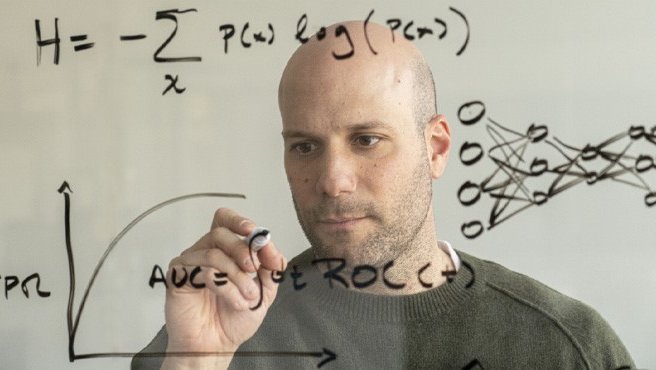
20.000 samplings under the H4H program
The H4H Program of the Center for Molecular Fingerprinting reached 20,000 samplings on 1st March 2023, marking another significant milestone in the project's life. Therefore, we have gathered some interesting figures to give you a deeper insight into our research.
The program currently has 10,523 enrolled individuals across Hungary, of which 6159 people have already come back a couple of times. The most impressive is that we have recruited 814 individuals who have returned and donated their samples four times already. And we are already looking forward to the 5th round of visits this year. So far, the highest number of samples has been taken on 14th November 2022, when 228 individuals arrived for visits at the different medical cooperation partners and donated their blood. Interestingly it turned out that 64% of the participants in the program are female, and 35% are male, with almost 30% of the enrolled individuals being over 56 years of age.
Given such a good turnaround and active participation with frequent returns of people joining the H4H study, our database is continuously growing. In this way, we are pleased to see a strong willingness to not only join in – but also become a "living" part of the H4H study program. This way, in a joint venture – with study participants, clinical partners, and an interdisciplinary CMF team – we are moving the frontiers of infrared laser-based diagnostics for the future of healthcare!
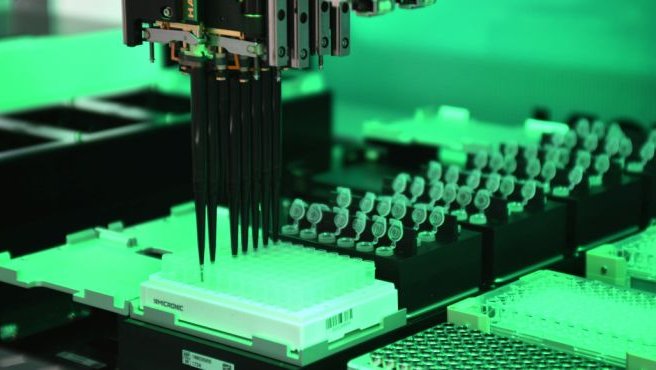
Anne L’Huillier, Paul Corkum, and Ferenc Krausz receive the Frontiers of Knowledge Award
The BBVA Foundation Frontiers of Knowledge Award in Basic Science goes in its fifteenth edition to three pioneers of ultrafast laser physics: Anne L'Huillier, Paul Corkum, and Ferenc Krausz.
In its citation for this year's award, the prize committee concluded that the awardees “have shown how to observe and control the motion of electrons in atoms, molecules, and solids with ultrashort light pulses on time scales of about one hundred attoseconds. One attosecond is approximately the time for light to travel across an atom and is the natural scale for electronic motion in matter. This time scale was previously inaccessible to experimental studies due to the lack of light pulses with short enough duration.”
CMF sincerely congratulates our scientific director Ferenc Krausz and his colleagues on this award!
For further and more detailed information, please visit:
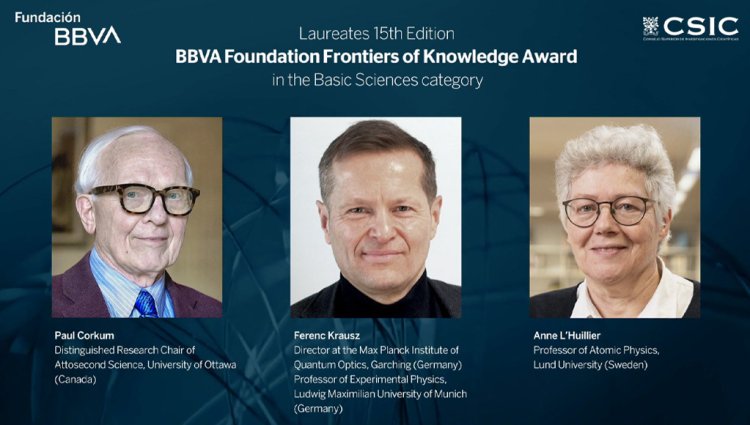
International Day of Women and Girls in Science - Interviews with Dr. Mihaela Žigman and Andrea Dr. Strádi
The International Day of Women and Girls in Science is celebrated on 11th February and it was established in 2015 to recognize the critical role women and girls play in science and technology. This international day is an opportunity to promote full and equal access to and participation in science for women and girls and to support gender equality.
On this occasion we talked to Dr. Mihaela Žigman and Andrea Dr. Strádi, who shared their point of view about women and girls in science.
Why is the International Day of Women and Girls in Science important?
Dr. Mihaela Žigman: Over history, women have not only participated in but also driven our understanding of the world and our place in it - including the way we do science today. There is no doubt that there are numerous examples of contributions from female scientists.
I do, however, not think or worry about female scientists in developed countries nowadays. Rather, I am more concerned about the fact that, for most of the world, it is a socioeconomic luxury to be able to learn, study and enjoy an intellectual career path, and more so for girls.
Related to the concept of this day, as we push forward in scientific frontiers, let us remember that moving mountains requires a team effort! Celebrating this day for me also means honoring diversity in thought and collaboration - as the key elements for meaningful scientific progress. In other words, I am not sure that the ladies could or should pursue science without their male partners in research.
Andrea Dr. Strádi: It’s a good occasion to emphasize, that science is not just for men! On the diverse palette of science, anyone can find a direction in which they can fulfil themselves, regardless of gender. So, on this day we can encourage young ladies to boldly choose a scientific career by presenting female role models and giving positive reinforcement.
What inspired you to become a scientist?
Dr. Mihaela Žigman: I am not entirely sure. Perhaps the inherent wish to better understand phenomena around us. The wish to understand how nature functions have always intrigued me.
Andrea Dr. Strádi: I love natural sciences and I've always been interested in how the universe works. There were many opportunities to get involved in research at university, so I could look into the world of scientists, which was pretty interesting. It was very attractive that one can travel around the world to attend conferences and meet intelligent (and absolutely not boring) people.
Was your journey challenging in the field where are less women?
Dr. Mihaela Žigman: In my work environment - in the Natural Sciences and Life Sciences - I would say that I had equal chances as a woman to proceed with a career. Especially when thinking about the possibilities and limitations of women scientists active in Europe, as compared to different cultures worldwide.
I have been working as a scientist in both female-dominated and male-dominated research laboratories at different institutes in Europe and the US. Overall, I never felt limited or challenged because of my gender.
I very much hope that science is the field of profession where our capacities can overcome questions of gender and whether males versus females have different capacities to become professionally acknowledged commensurate with their intellectual capacities.
The roads to what is considered to be "success" are diverse, and there are different meanings of it. Individuals who naturally show a higher drive, and feel it is natural to invest their personal lifetime in their work, tend to become more successful scientists. But it is no guarantee. The self-centered drive is biologically hard-wired and socially shaped and not necessarily the same between genders. On the other hand, those who can delegate work efficiently or make others work for their own benefit may also move up the ranks better. Yet, this reality is not new. And not specific to scientific careers.
Andrea Dr. Strádi: I did not notice or did not care about it in the science community. To be honest, I got very little encouragement from my family since they did not know what to advise a girl. The role model family members were mostly engineers, which is not a feminine profession. I was quite independent, so I walked my own path.
What was your best advice early on in your career?
Dr. Mihaela Žigman: That it is essential to identify "a topic" that personally fascinates you so that you can thrive as an individual when studying it. Whatever that phenomenon, problem, or theme is, it will most likely be of secondary importance. But one needs to have sufficient personal satisfaction from working on a specific problem. So figure out what triggers your interest most to start with!
Andrea Dr. Strádi: One of my professors encouraged us to join the Scientific Students' Associations (research opportunities for students supervised by professors resulting in a thesis presented at the yearly faculty conference & nationwide competition in every second year). It was a great experience; I learned a lot.
What would be your advice to the girls who want to become scientists?
Dr. Mihaela Žigman: If you are deeply interested in a topic, keep looking further. Dig deeper!
Andrea Dr. Strádi: Be open to possibilities and dare to knock on doors “of giants”! Many times, a fruitful joint work is only a handshake away. Also, it's natural to start small (take on an assistant position or volunteer work), being a useful scientist is a longer process.
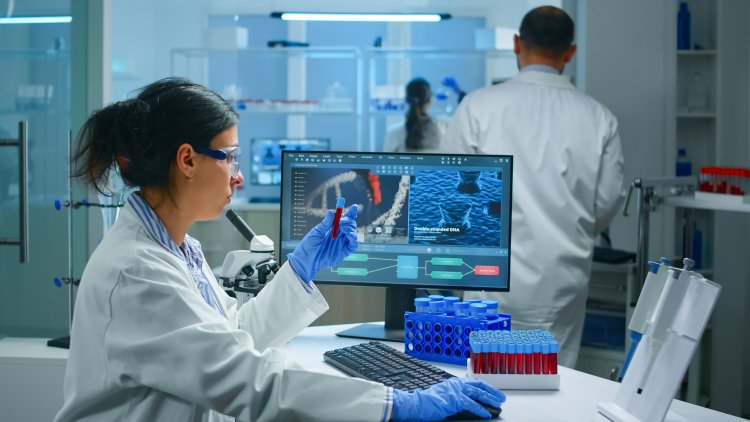
Welcome Csaba and Krisztián
Csaba Liber did his MSc in Electrical Engineering at the Budapest University of Technology and Economics, specializing in intelligent robots and vehicles. Since then, he has worked on several projects applying machine learning, artificial intelligence, and other automated object and person recognition techniques.
Csaba developed automated traffic counting for Zoosh, developed algorithms for collision avoidance for Knorr-Bremse Rail Systems, and used neural networks for passenger counting and object detection at Adaptive Recognition Hungary. He just joined the CMF Laser Science Team as a computer scientist. He will work on new algorithms for ultra-precise infrared molecular fingerprinting and develop the software for our next-generation instruments.
Krisztián Borbély joined CMF as a data analyst as part of our Data Science Division, the team led by Mihaela Žigman. He is responsible for the data science processing and analysis of clinical trial data and measurement data for research and development activities and its project management, particularly in close collaboration with the Laser Science Division, the Clinical Research Division, and the Life Sciences Division. Krisztián studied at the Eötvös Loránd University and has his MA degree in Psychology, with a specialization in cognitive psychology and neuroscience, and plans to finish his Ph.D. this year. While he has always loved the whole field of cognitive psychology, it was the methodology and statistics part of the research processes that interested him the most. As a result of this, he transformed into a data analyst/data scientist and worked in the last couple of years.
As Love Data Week takes place from February 13 to 17 this year, the goal of this week is to celebrate data and raise global awareness about the importance of data science and management. It is a perfect opportunity to share their thoughts about data science and give a little personal touch to their introduction:
What inspired you to become a data scientist and work in this field?
Krisztián Borbély: I find it fascinating how every entity in the world has much more information inside it than that you can see on the surface. With correct measurements and procession of the data, people can cognize the world around them more precisely. Data analysis almost became like the sixth sense of humans ever since science existed. There are an insane amount of things in the universe that you can't experience directly, but through the data some kind of measurement technology collects, you can be aware of their existence. Sorry if I got very philosophical very quickly. :D
\r\n\r\n
Csaba Liber: I always had a curiosity about how things work. One can think of computer science as a tool to model and help us understand the patterns behind a complex, real-life systems.
\r\n\r\n
What is the biggest challenge in this field?
\r\n\r\n
Krisztián Borbély: This might not be the biggest, but riskiest. It's to identify the hidden inherent errors that can be found in almost any kind of dataset. Some can be extremely hard to spot, and if one fails to do that, that can lead to false conclusions and derail you from the right track.
\r\n\r\n
Csaba Liber: It is a constantly evolving field with broad application possibilities. So, it is just hard to keep up with new improvements. Still, one of the biggest challenges is balancing between applying new technologies and supporting the already existing and well-working systems.

Articles presenting CMF's work in the latest issue of the Pulse magazine
The latest issue of Pulse, the magazine of Attoworld, was published in December 2022. In this publication, an interview with Dr. Alexander Weigel, the Chief Laser Scientist of CMF, can be found. He shared details about his and the CMF’s laser science team’s research, vision, and goals.
He and Dr. Mihaela Žigman, the Research Director of CMF, published an other article, “Framing the Yin & Yang of human health”, where you can learn more about establishing electric-field molecular fingerprinting for in vitro diagnostics and the large-scale human medical testing.
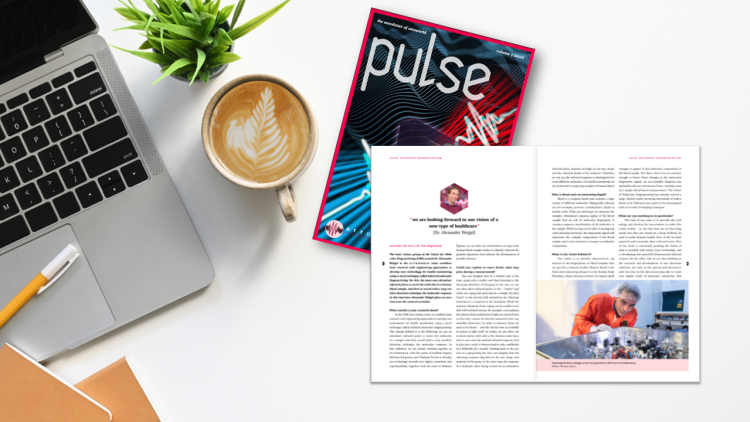
Successful year for the H4H Program
The Molecular Fingerprinting Research Center's H4H Program has had a successful year and achieved several milestones.
The total number of samples exceeded 14,000 by 16 December 2022, while the number of participants involved in the research reached 8,500. Meanwhile, with a low attrition rate, participation remained steady, which is essential to validate our diagnostic method.
Thus, it was particularly important that on 14 December 2022, the number of people who had returned for the third time reached 1,000. In the analysis planned for the first half of 2023, these samples will be the ones that will further strengthen the scientific value of molecular fingerprinting.
Throughout this year, we have worked continuously to make the H4H Program accessible to as many people as possible. As a result, 10 new centers have been opened, and the network of participating sampling sites is now complete. This means that volunteers can provide samples at 20 centers in 14 cities across the country.
We are delighted to see the number of participants in the H4H Program increasing, bringing us one step closer to developing a new personalized, infrared laser-based diagnostic tool for the future of healthcare.
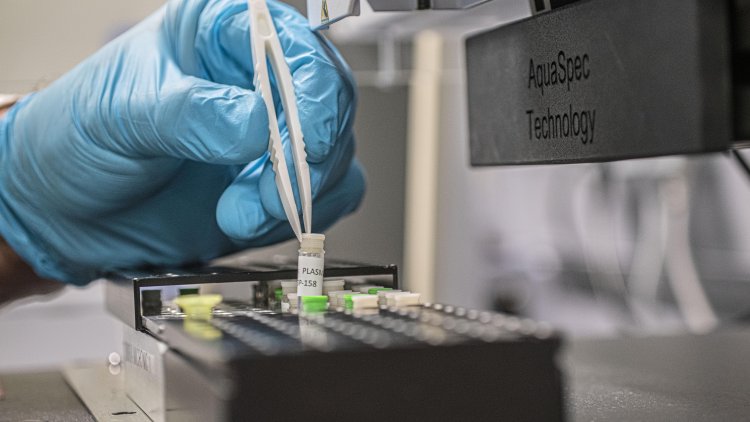
Welcome, Behnam!
The CMF's team welcomes Behnam Abbasvand Jahedi. Behnam has studied electrical engineering at Tabriz and Urmia Universities in Iran and focused during his master's degree on micro-electromechanical systems (MEMS). Before joining us, he co-founded the start-up Dolphin E.F.P., developing custom electronic solutions for industrial customers.
With his expertise in electronics and circuit design, he will join the CMF laser science team and work on the development of high-performance electronics for our next-generation field-resolved spectroscopy devices.
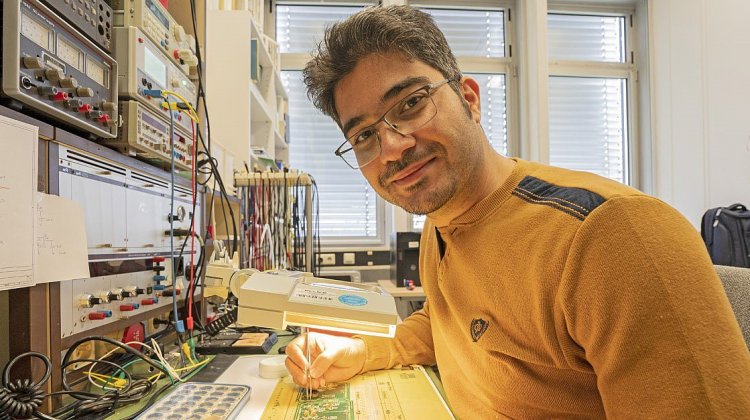
Ferenc Krausz held this year's Einstein lecture in Berlin
The “Einstein Lectures Dahlem”, hosted by Freie Universität Berlin since 2005 in partnership with several external institutions, are dedicated to the epochal work of Albert Einstein. On November 2nd Ferenc Krausz was honored to hold the 21st Einstein Lectures in Berlin.
In his popular science lecture “Electrons and Light Waves - Together against Cancer," Ferenc Krausz spoke to an audience of 500 invited scientists about the basic research in the field of attosecond physics that he and his research groups are playing a significant role in developing. He also gave exciting and promising insights into the potential applications regarding early diagnosis of serious diseases using the individual “molecular fingerprinting” method. Krausz told the interested audience that "light is our most sensitive probe for the atomic and molecular world. High-precision measurements of light using attosecond metrology now enable the detection of minute changes in the molecular composition of blood. This new capability paves the way for early detection of cancer and other diseases, meaning that it can potentially save lives."
At the end of his presentation, Krausz also solicited support for the "Science4People" initiative, which he initiated with the worldwide backing of scientists and local aid organizations in war-torn Ukraine. The aim is to improve the welfare and education of children and young people in need, a generation that is supposed to rebuild the country after the war.
The German presentation was recorded and can be accessed via the following link:
21st Einstein Lecture: Prof. Dr. Ferenc Krausz | Electrons and Light Waves -Together against Cancer - YouTube
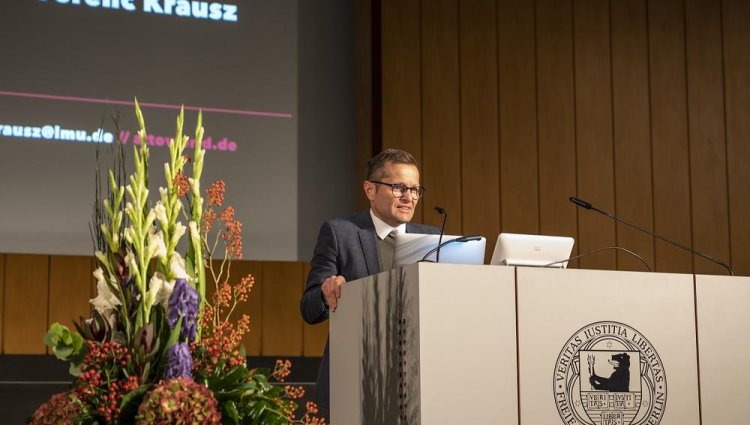
The H4H program reached new milestones
We are happy to share that the CMF’s H4H Program reached new milestones, as on 26th of September 2022, the study enrolled the 5000th individual making the overall number of samples more than 7300. As new people are joining, and our database is getting bigger, we are glad to see that the willingness to stay part of the research and donate blood samples from time to time is getting stronger, which is a crucial factor in our method.
Nothing proves this better than the fact that on 26 September 2022, one of the participants gave a blood sample for the 4th time.
We are continuously working to bring the H4H program closer to more and more people. In September 2022, we expanded our sampling center network, so now, 17 centers in 13 cities across Hungary have permission to collect blood samples as part of the H4H program.
We are happy to see the growing number of H4H participants and new sampling centers joining, which step by step brings us closer to developing a novel personalized infrared laser-based diagnostic tool for the future of healthcare.
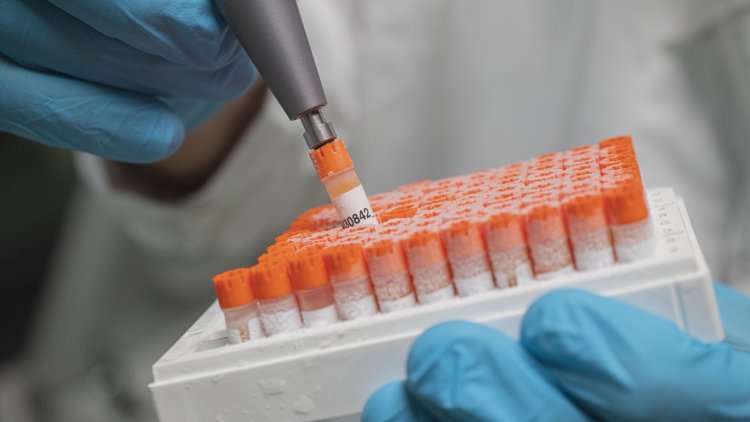
CMF presents at Attoworld-Meeting
Every autumn, the research groups of the Attoworld meet under the leadership of Prof. Ferenc Krausz in their Attoworld-meeting on the research campus Garching. From September 20 to 22, 2022, the scientific group leaders presented the current results of their research with a view to the progress achieved in the past year and gave an outlook on the future development of their research area.
For the "Center for Molecular Fingerprinting" (CMF), Dr. Mihaela Žigman, leader of the department "LIFE SCIENCE," and Dr. Alexander Weigel, head of "LASER SCIENCE" gave their presentations. Both are working closely with their groups on the detection and scientific evaluation of molecular fingerprinting for the early diagnosis of diseases.
The event served not only to provide information but also to stimulate lively and result-oriented discussions among experts. And even away from the lectures, there was an opportunity for vivid exchange and strengthening of bonds. Thus, the meeting ended with a joint hike around the Upper Bavarian Schliersee to get the heads free again for new inspirations. One can, therefore, already be curious about the results and scientific advances in the coming year.
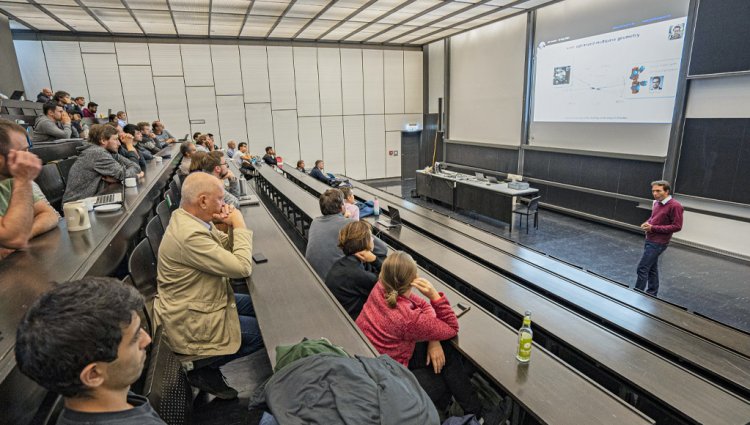
Invited talk at the Europhoton Conference
In an invited contribution at the 10th Europhoton Conference in Hannover (28th August until 2nd September 2022), Dr. Philipp Steinleitner, who is working in close cooperation with the CMF Laser Science Team led by Dr. Alexander Weigel, has just presented the results he obtained together with Nathalie Nagl (LMU) and Maciej Kowalczyk (CMF).
He showed how to generate extremely stable infrared pulses comprising only a single oscillation cycle of the light electric field and how to control their waveform.
More details about this work based on our new Cr:ZnS laser platform can be found in our latest Nature Photonics publication: https://www.nature.com/articles/s41566-022-01001-2
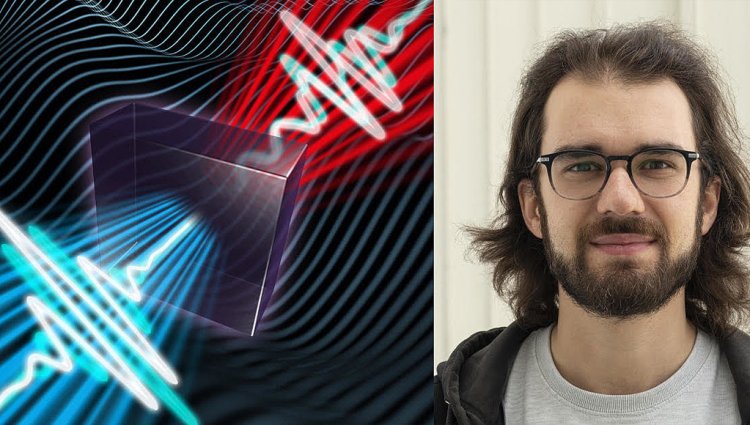
The bright future of Attosecond physics
The editors of Nature Photonics have taken the occasion of this year's award of the Wolf Prize to Paul Corkum, Anne L'Huillier and Ferenc Krausz to shed special light on Attosecond physics. CMF's laser systems for infrared spectroscopy of blood samples are also based on this fundamental research.
The editors welcome this year’s award, which pays tribute to the growth that Attosecond science has experienced in the last decades. In Nature Photonics they celebrate the award with interviews with the three prize winners, who share their views on the development of the research field, the unanswered questions and the exciting opportunities laying ahead.
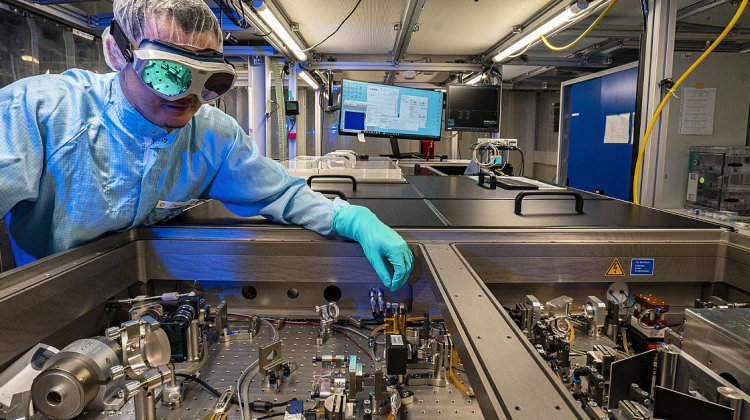
CMF gains biobank licence
CMF started the application process for a biobank license earlier this year, and we are proud to announce that after an inspection on the 20th of July, the NNK (National Public Health Center) has granted the license for our interim biobank at Szeged.
Our new biobank is equipped with 2 -80 °C ultradeep freezers with a storing capacity of 40 000 aliquots per equipment. To ensure sample security, one of the freezers serves as a backup. In case of an emergency, text message and email is sent to Biobank operators to give enough time to save samples. Gaining a biobank license is an important step forward in CMF’s life.
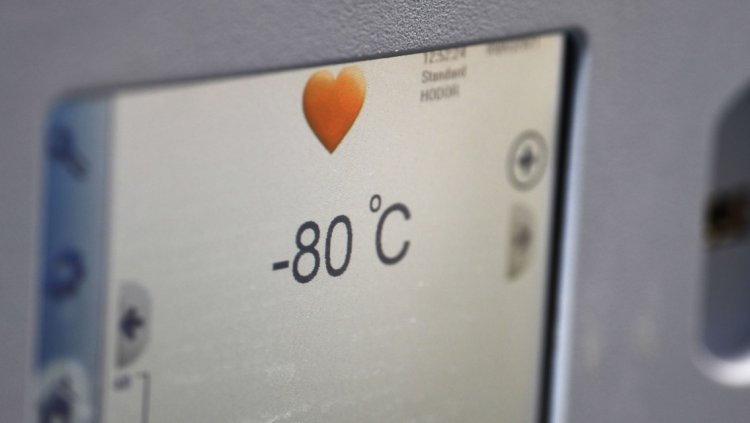
Ferenc Krausz and Nathalie Nagl at Atto VIII Conference in Orlando, Florida
From June 11-15, 2022, the 8th International Conference on Attosecond Science and Technology was held at the University of Central Florida in Orlando. In advance of the expert conference on ultrashort pulse physics, more than 300 scientific papers have been submitted by experts researching this subject.
The conference kicked off last Monday with a tribute to this year’s Wolf Prize winner in physics. Anne L'Huillier, Paul Corkum, and Ferenc Krausz, all luminaries in the field of attosecond physics, gave a talk on their current research. Under the title “Attosecond Metrology 2.0: From Tracking Electronic Motion to Probing Human Health“, Ferenc Krausz, Director at the Max Planck Institute of Quantum Optics and Professor of Experimental Physics at the LMU as well as Scientific Director at the Center for Molecular Fingerprinting (CMF) in Budapest, gave a virtual lecture on his primary research and that of his research groups in the field of ultrafast physics. There was a particular focus on the promising applications in the early medical detection of diseases such as cancer, which can be detected at the molecular level using laser-based infrared spectroscopy. Krausz is working on this research with parts of his attoworld team and CMF in Budapest.
Nathalie Nagl, who currently works as part of the AMPiii and CMF Laser Research teams on making the vision of probing human health with attosecond metrology reality, also gave a presentation on “Single-cycle infrared waveform generation and control”. Together with Philipp Steinleitner and Maciej Kowalczyk, also main authors of this work, she demonstrated a new, extremely broadband, stable single-cycle infrared laser source with control over the waveforms of the emitted pulses. For her PhD thesis on the development of the laser driving this unique source, she recently received the Otto Hahn Medal of the Max Planck Society. This is the eighth time the conference has brought together leading experts in the science of attosecond physics and provided a forum for the latest research results and discussions.
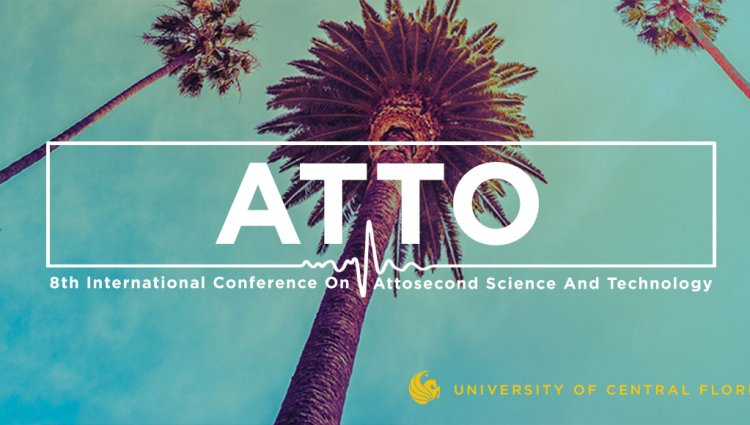
Ceremonial award of the Otto Hahn Medal to Dr. Nathalie Nagl
In mid-March, we reported that Dr. Nathalie Nagl, a physicist at the Max Planck Institute of Quantum Optics (MPQ) in Garching near Munich, would be honored with the Otto Hahn Medal, an award for early achievements in the field of physics, for her outstanding research results in the course of her doctoral thesis. The ceremony took place at the Max Planck Society on June 22, 2022 in Berlin. Dr. Nagl received the award from Prof. Klaus Baum, Vice President of the Chemical-Physical-Technical Section of the Society.
Nagl receives the prize for the development of femtosecond lasers in the mid-infrared spectral range, which will significantly accelerate the widespread application of novel spectroscopy techniques in biomedicine. This new laser technology (diode-pumped Cr:ZnS lasers), which Nagl developed as part of her doctoral thesis, will be the basis for all of CMF's new infrasampler laser systems (ISA3.0). Dr. Nathalie Nagl was therefore recently appointed "project leader" for ISA3.0 and will be responsible for completing two systems based on the laser technology she developed by the end of this year.
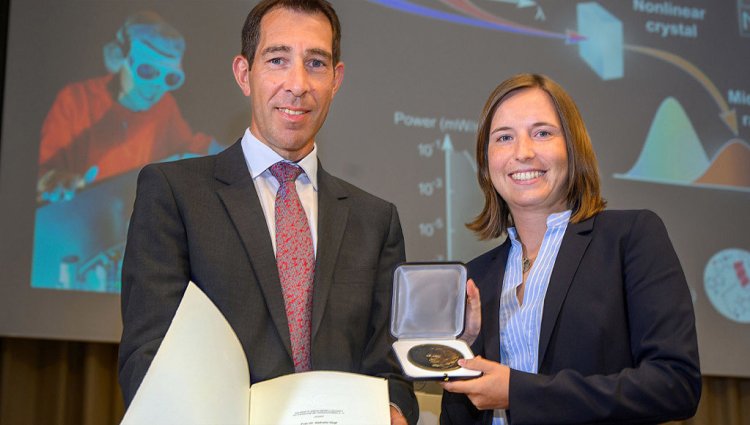
Mihaela Žigman presented at SPEC 2022 in Dublin
The 12th International Conference of Clinical Spectroscopy was held in Dublin from June 19-23, 2022. In her presentation “Electric-field molecular fingerprinting of blood: new prospects for probing human health“ Dr. Mihaela Žigman, head of the attoworld research group BIRD (Broad Band Infrared Spectroscopy) at the Ludwig-Maximilians University of Munich and Research Director at the Center for Molecular Fingerprinting (CMF) in Budapest, presented current research results in laser-based infrared spectroscopy and its promising applications in the field of diagnostic early detection of diseases at the molecular level in the presence of an international audience of experts.
Asked about her impressions of the biannual conference, Dr. Žigman stated, "Due to the global COVID pandemic, the event had to be cancelled last time. I am pleased that the conditions were now in the proper state again for the SPEC conference to be held in person this year. The event was very interesting and educational for all participants!"
Original publication:
Mihaela Žigman and Ferenc Krausz "Electric-field molecular fingerprinting of blood: new prospects for probing human health", Proc. SPIE 11655, Label-free Biomedical Imaging and Sensing (LBIS) 2021, 116550Z (5 Ma 2021); https://doi.org/10.1117/12.2587329
Abstract:
Recent advances in ultrafast laser science have opened new prospects in probing living systems. Suddenly-excited molecular vibrations emit picosecond-duration coherent infrared light characteristic of the sample’s composition. Given the capacity of this electric-field molecular fingerprint (EMF) to cross-molecularly probe organic samples, we evaluate the feasibility of EMF for biomedical diagnostics. We report high stability of EMF over time and show that several cancer entities leave their signatures in the EMF of serum. Leveraging on the advances of stability, reproducibility and sensitivity of EMF, we provide foundation for applications of infrared molecular profiles in the preventive care model of health monitoring.
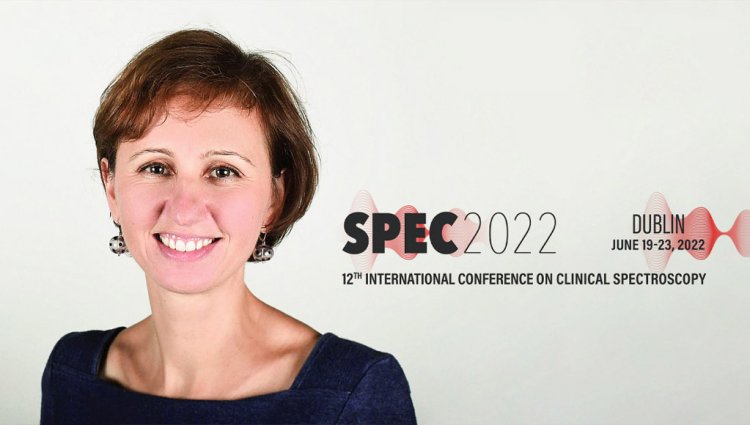
Wolf Prize Ceremony 2022
After the winners of the Wolf Prize were announced in February 2022, the awards were ceremonially now presented on Thursday, June 16, in the Knesset, the unicameral legislature of Israel. Our whole team would like to congratulate Ferenc Krausz again, who, together with Anne L'Huillier and Paul Corkum, received the Honorary Award for Physics this year.
The jury justified the prize to Ferenc Krausz "for pioneering contributions to ultrafast laser research and attosecond physics". In his acceptance speech, the awardee thanked his current and former team members for their joint success and his family, especially his wife, for their heartfelt support. He also announced his intention to donate the prize money to the initiative science4people.org, which he launched with team members under the worrying impressions of the war in Ukraine. Together with aid organizations such as the youth organization STAN, this cross-border project of scientists is currently working in war-torn Ukraine to help the needy and refugees, especially in education, which is presently often denied right now. More projects in other oppressed regions will follow in the future and be made possible by generous donations like this one.
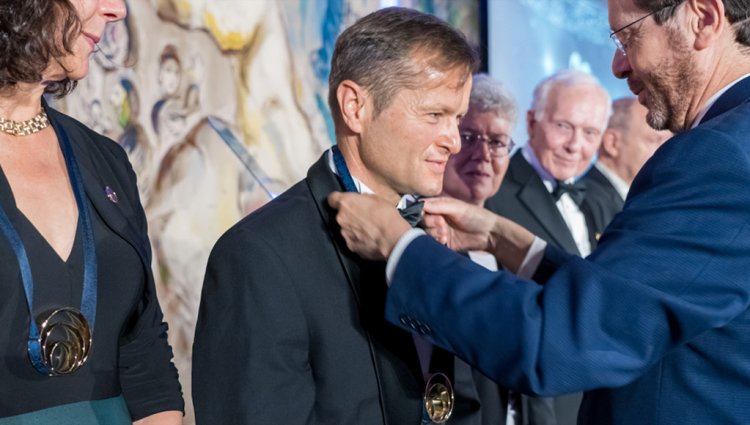
"We might be able to know if there is a problem even before symptoms appear"
In cooperation with the Budapest University of Technology and Economics the analysis of the molecular composition of human blood using ultra-short pulse laser technology can be realized in Hungary.
Prof. Ferenc Krausz, Scientific Director of the CMF, studied electrical engineering at the Technical University of Budapest and theoretical physics at the Eötvös Loránd University. "As a student, I attended wonderful lectures at both institutions. I had outstanding researchers and teachers who left a legacy of professional achievements that have influenced the lives of generations," he said of his mentors György Marx at ELTE and Károly Simonyi at BME.
Ferenc Krausz and his research group are currently investigating the medical diagnostic potential of short-duration light pulses. The renowned physicist initiated the establishment of the Center for Molecular Fingerprinting (CMF) in Hungary 4 years ago. Thanks to the support of the Minister of Innovation and Technology László Palkovics and the Hungarian government, the research center was established in May 2019 under the auspices of the Ministry of Innovation and Technology (ITM).
CMF's H4H Program aims to use artificial intelligence to discover which diseases can be deduced by doctors from the infrared molecular fingerprints generated during blood analyses.
"We need a large number of samples to document the molecular abnormalities caused by each pathological lesion. To this end, we have set up the H4H Health for Hungary - Hungary for Health program, in which we plan to conduct a series of clinical trials involving 15,000 subjects over 5 years in the first phase. Participants in the program will be asked to donate blood several times a year. The first few times will be used to determine the personalized normal (healthy) range of the molecular fingerprint. Then the follow-up tests will monitor whether the fingerprint remains in this range or leaves it permanently," said Ferenc Krausz, explaining the promising potential for improving the quality of human life.
As a first step in the implementation of the project, CMF plans to set up a temporary laboratory for laser research and analysis of blood samples. Intensive discussions are currently underway with the Chancellor's Office of the University of Technology to set up the temporary laboratory. The long-term research base of the CMF is planned to be built in the next few years on the vacant site between the Budapest University of Technology and Economics building I and the Eötvös Loránd University TUT facility in Lágymányos.
The full interview is available in Hungarian here.
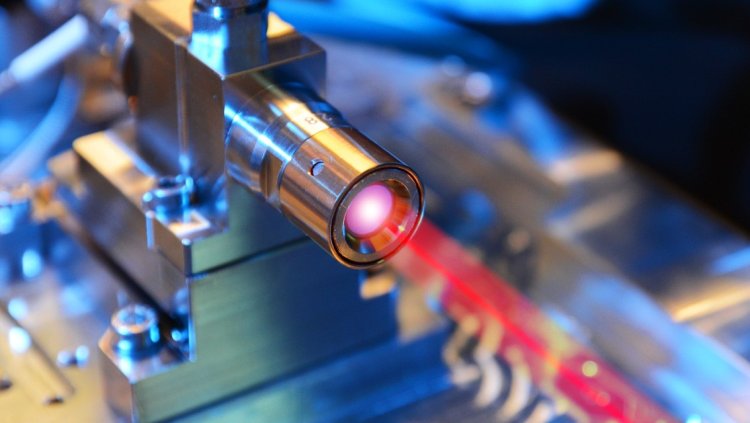
Prof. Ferenc Krausz interviewed by Magyar Nemzet
Prof. Ferenc Krausz, Scientific Director of CMF, gave an interview to one of the major Hungarian newspapers, Magyar Nemzet.
"No time for daydreaming!" - he said in the interview. Prof. Krausz has recently turned 60 and is very conscious of spending the time he has on the most important things.
As head of the Center for Molecular Fingerprinting in Budapest, he explained in the article how his research focuses on the molecular fingerprinting of blood to develop a new generation of molecular diagnostics. The stakes are huge. The technique has the potential to become a cornerstone of future preventive healthcare, creating exceptional value for individuals and society.
The feature also mentions that in his spare time, Prof. Krausz has mobilized his international network of contacts to launch a fundraising campaign (www.science4people.org) to help those affected by war.
The full interview is available in Hungarian here or download pdf.
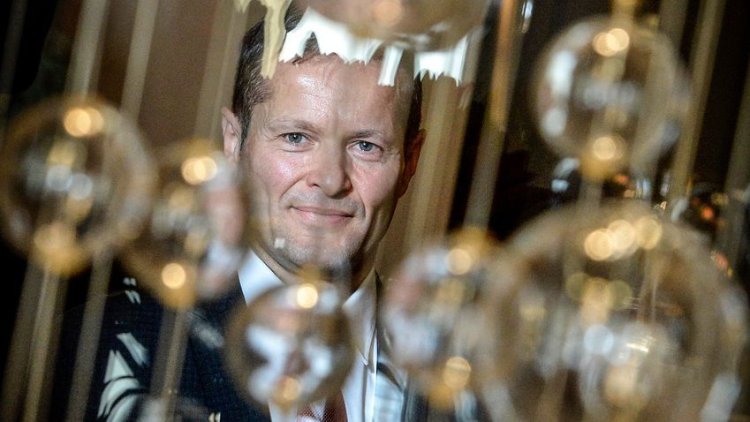
The CMF laser science team
Today we would like to briefly introduce the CMF Laser Science Team and what they are currently working on.
Our international team, led by Dr. Alexander Weigel, combines laser and metrology development with engineering to develop new instruments for future health monitoring with field-resolved infrared spectroscopy.
As the future laser platform, we develop ultrafast Cr:ZnS oscillators, which are directly pumped by low-noise laser diodes. Aleksandar Sebesta and Arun Paudel have just completed a first engineered laser prototype, which produces few-cycle pulses at 2.4 µm with a new level of power stability. Together with Matthias Stadter, our mechanical engineer, they are already working on the next-generation laser prototype, which will form the basis for the new metrology system. Meanwhile, Dr. Maciej Kowalczyk stabilizes the carrier envelope phase of these lasers to record-low levels. In order to boost the output power further, Dr. Shizhen Qu develops Cr:ZnS amplifiers with low-noise diode-pumping technology. Yudong Sun assists with laser characterization. We will use these unique sources for multi-octave-spanning mid-infrared generation and record the infrared response of human blood samples with field-resolved detection.
Simultaneously, we are already pushing the field-resolved infrared measurement technology using systems based on high-power Yb:YAG thin-disk lasers. Dr. Christina Hofer currently coordinates the upgrade of such a system to kHz-rate optical scanning using two synchronized laser oscillators. Dr. Sebastian Gröbmeyer uses nonlinear compression to achieve broader bandwidth in the infrared pulses and extract more information out of the biological samples. Dr. Abhijit Maity, Dr. Wolfgang Schweinberger, and Dr. Dionysios Potamianos work on the detection with ultra-rapid electro-optic sampling. Hojjat Heydarian from the ACCORD team supports us with the development of new detector electronics. Our computer scientist, Patrik Karandušovský, develops algorithms for high-speed delay calibration of the dual-oscillator scan with attosecond precision. In March 2022, the system will move to the CMF National Laboratory in Hungary, where it will be used to analyze blood samples and identify disease-specific infrared fingerprints.
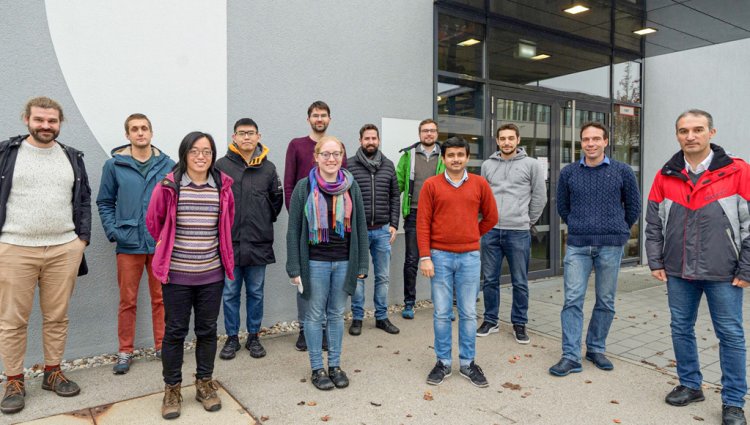
Prof. Ferenc Krausz in an exclusive interview
Prof. Ferenc Krausz, a coriphae in the field of attosecond physics and Scientific Director of CMF, was awarded the prestigious Wolf Prize 2022 in February. On the occasion, he currently gave an exclusive interview to iGlobenews magazine. Herein, Prof. Krausz talks about the basic research of ultrashort pulse laser physics and its concrete application possibilities, which are emerging in the field of personalized preventive healthcare, developed in collaboration with the Center for Molecular Fingerprinting. You can currently read the whole interview in English here or as a pdf.
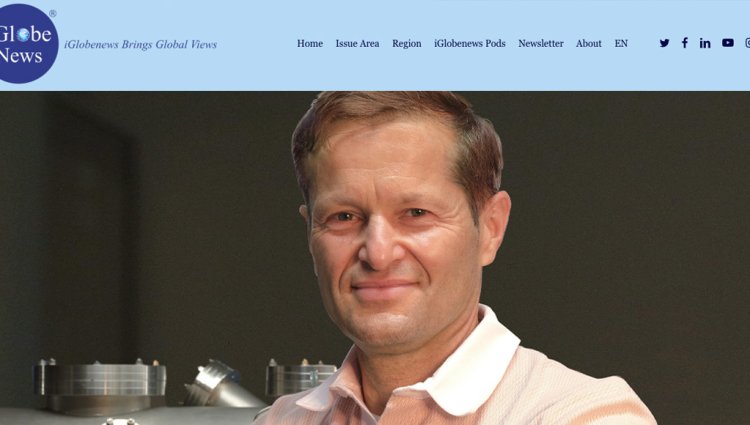
On the catch for gastrointestinal tumors
Is infrared molecular fingerprinting useful for detecting gastrointestinal tumors? That's what the Lasers4Life team (L4L), a key CMF collaboration partner in Germany, is trying to find out for the first time in a new study. The project has now been launched at the University Hospital of Tübingen, one of the world's leading universities for life sciences, and medicine in the center of Baden-Würtemberg.
The researchers have already proven that the method of infrared molecular fingerprinting has the potential to detect different types of cancer (eLife 2021; DOI: https://doi.org/10.7554/eLife.68758 ). But can infrared spectroscopy also be used to detect pancreatic, liver or colon cancers? That has not yet been studied experimentally. The pilot project "Laser-based detection of gastrointestinal tumors and their recurrences" is being carried out by the L4L team in collaboration with the Medical Clinic, Internal Medicine I, of the University Hospital Tübingen (UKT). The researchers will use infrared spectroscopy to analyze blood samples from cancer patients for their molecular composition. Both the conventional FTIR method and, in parallel, the infrared laser spectroscopy newly developed in collaboration with CMF will be used. The aim is to investigate whether molecular infrared fingerprinting can be used as a new, non-invasive method for the efficient examination of human blood to detect cancers of the gastrointestinal tract. An exciting start to an ambitious project and a new collaboration!
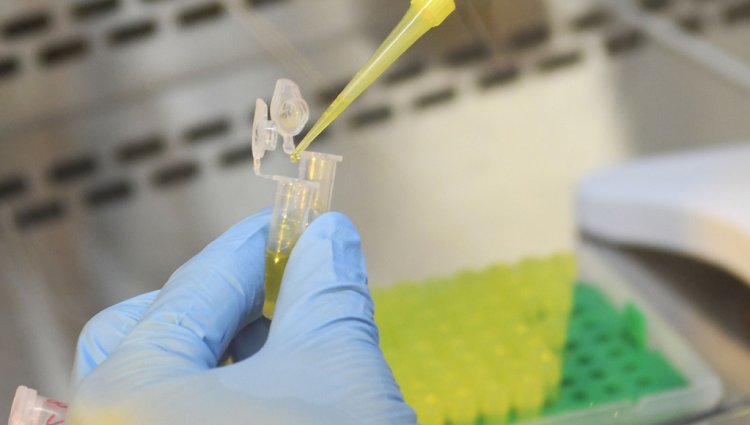
Otto Hahn Medal for Future CMF Infrasampler Laser Systems (ISA3.0)
Dr. Nathalie Nagl, a physicist at the Max Planck Institute of Quantum Optics in Garching near Munich, will be honored with the Otto Hahn Medal of the Max Planck Society for the year 2021. The award is given in recognition of outstanding achievements from the first creative period of young scientists. Nagl will receive the award for developing femtosecond lasers in the mid-infrared spectral range, which will significantly accelerate the broad application of novel spectroscopy techniques in biomedicine.
This new laser technology (diode-pumped Cr:ZnS lasers), which Nagl developed during her doctoral research, will be the basis for all of CMF's new infrasampler laser systems (ISA3.0). As a result, Dr. Nathalie Nagl has recently been appointed "project manager" for ISA3.0, and she will be responsible for completing two systems based on her developed laser technology by the end of this year. The medal will be awarded to Nathalie at the annual meeting of the Max Planck Society during the meeting of the Chemistry, Physics, and Technology Section on Wednesday, June 22, 2022, in Berlin. We warmly congratulate Dr. Nathalie Nagl on this highly deserved award!
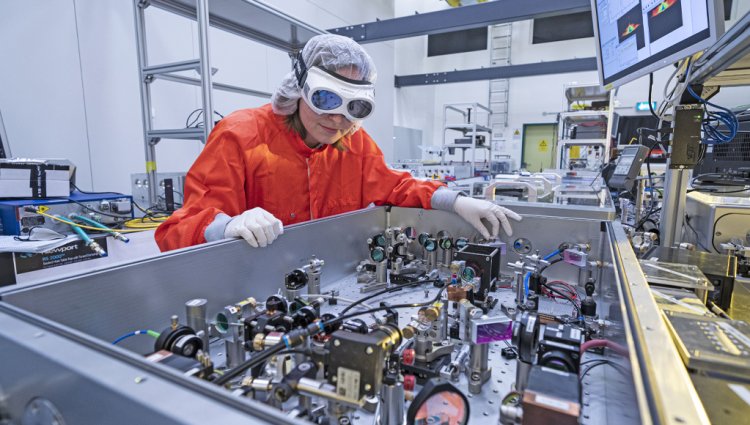
Dr. Mihaela Žigman presents H4H Program in Munich
An exciting evening was experienced by the guests on March 9, 2022, in the Hall of Honor of the Deutsches Museum in Munich. It is the world's largest museum of science and technology, which regularly offers an extensive accompanying program on current research topics. In her presentation "Infrared sensing as a new monitor of health", Dr. Mihaela Žigman, Research Director at CMF and head of the BIRD (Broadband Infrared Diagnostics) research group in the attoworld team, gave insights and outlooks into the field of her research area on molecular fingerprint detection and analysis.
She explained to the interested audience how ultrashort pulse laser technology could be used in the future in medical applications for the early diagnosis of diseases such as cancer and highlighted the first promising research results. She also provided a detailed presentation of the large-scale Lasers4Life and H4H (Health for Hungary) studies in Germany and Hungary. A question and answer session at the end of the lecture showed the great interest of the audience and brought the informative evening to a successful close.
The presentation in German can be viewed on the youtube channel of the Deutsches Museum:
https://www.youtube.com/watch?v=SblAhdYc8og&list=PLqvZktQdyL4teBsJsb7Sn2pCLdnJLQEXv
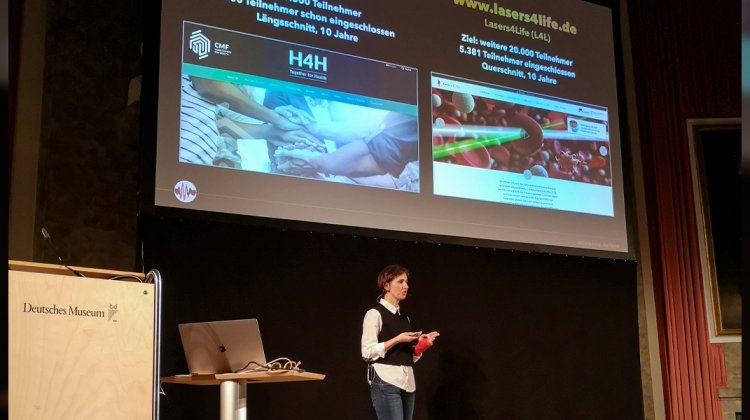
New Infrasampler technology on the clinical test run
Extensive efforts by the CMF, LMU and MPQ teams have been advancing together the frontiers of laser science over the last years. But we are turning on a new page here: The time has come to finally apply and evaluate the latest technological advances for its possible applications in medicine. And the quest to evaluate whether Infrasampler 1.5 technology will level up in vitro cancer diagnostics is on!
In a joint effort, scientists from the Max-Planck-Institute for Quantum Optics (MPQ), the Ludwig-Maximilians University Munich (LMU) and the Center for Molecular Fingerprinting Research (CMF) have developed the Infrasampler 1.5 - a new device for field-resolved molecular fingerprinting of human blood samples. Proudly and excitingly - the first pilot application on human blood serum just started. Here the performance of the new laser-based spectrometer will be evaluated to identify molecular fingerprints specific to prostate, breast and lung cancer.
The Infrasampler 1.5 uses ultrafast high-power lasers from the LMU research laboratories to create mid-infrared pulses and excite the molecules in the human, blood-based samples. Imagine the event like a mallet hitting a gong: With the ultra-sensitive field-resolved detection the new capacity to listen to the ringing that follows the gong is available. And the recorded echo-like signatures from human serum are characteristic to the molecular composition of the sample. Now the quest is to figure out whether these signals from human samples are corelating with human physiologies and diseases like cancer.
The metrology has been developed by the team around Dr. Ioachim Pupeza, group leader of the field-resolved metrology development, who has teamed up with the group around Dr. Alexander Weigel, chief laser scientist. They are grateful for contributions of Philip Jacob, Phd student, Dr. Christina Hofer, non-linear optics expert, along with the support of Dr. Wolfgang Schweinberger, senior scientist. Developing this new technology was a truly multi-disciplinary endeavor and required scientists and experts from fields as diverse as laser physics, nonlinear optics, computer science, data analysis and bioengineering to work together.
But these are not all. For the whole endeavor even more professionals are intricately networking here. On the computer scientist side, Patrik Karandušovský is developing the algorithms and control programs for the system, while Dr. Maximilian Högner, postdoctoral scientist, developed data analysis procedures. And getting to molecular level, the broadband infrared diagnostics (BIRD) team around Dr. Mihaela Zigman is enabling the biological and even real-world clinical settings to be evaluated. It is the expertise of Dr. Michael Trubetskov, Dr. Kosmas Kepesidis, Dr. Marinus Huber, Dr. Frank Fleischmann, Eric Grießinger that is after the molecular fingerprint echos, which they are correlating with the medical parameters, managed by the clinical study team around Jacqueline Hermann.
What is new within the Infrasampler 1.5 technology? Compared to previous similar instruments, Infrasampler 1.5 is now equipped with a new ultra-rapid scanning technology, which enables us to record up to 3000 measurement scans per second, compared to previously just one trace per second. A new milestone in the field. The vision is to use the Infrasampler technology as a standardized technique for future medical applications, and the launch of the first Infrasampler 1.5 measurements is another important milestone on the way.
The path for shaping the future of healthcare may be challenging, with many multi-level problems to be tackled. Even so, the cross-disciplinary strength and the power of great minds from LMU, CMF and MPQ acting in such unison while pursuing the mission may turn out imperious. For the future of technologies involved, as well as their applications.
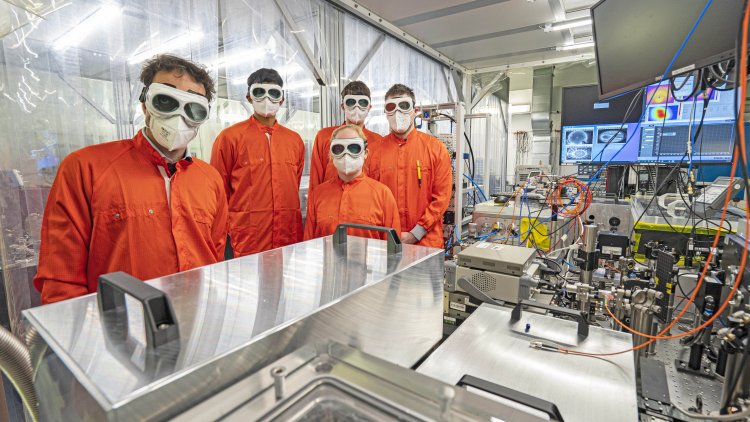
A new clinical study for prostate cancer detection launched
Prostate cancer, the leading type of cancer in men, is still challenging to be diagnosed at an early stage when mostly asymptomatic or indistinguishable from other urinary problems. The current methods for reliably detecting and distinguishing early prostate cancer lesions are not feasible without tissue biopsies. A new infrared spectroscopic method could be a game-changer to analyze exprimate urine. Non-invasive and without radiation hazard.
Very close collaborators of CMF – from the Broadband Infrared Diagnostics (BIRD) team at the LMU Munich - just initiated a new clinical study entitled "Infrared Spectroscopy of Blood and Exprimate Urine for Prostate Cancer Detection". This clinical trial is set to provide proof of concept for the ability of a drop of exprimate urine as a new test to reveal the presence of prostate cancer. The study is inherently interdisciplinary, combining laser physics, molecular biology, and prostate oncology efforts. It was initiated at the end of January at the Ludwig Maximilans University (LMU) Hospital, Department of Urology in Munich. At the clinic, Dr. Michael Chaloupka leads the program managed by the BIRD clinical trial team. They have defined the study's framework and successfully enrolled the first participating patients!
In addition to the clinical team in the hospital at Grosshadern, located south of Munich, the investigations are going on in the north of Munich, at the LMU in Garching, just as well. The researchers of the BIRD team are applying the latest advances in infrared spectroscopy and ultrashort pulsed lasers to build a prostate cancer detection test - based on infrared molecular analysis of human exprimate urine so they can compare the molecular makeup of exprimate urine and blood plasma from patients with prostate cancer with those from control individuals.
Infrared fingerprinting analyzes organic molecules to decipher healthy and prostate cancer states by studying the dynamic biochemical suite found in the bodily fluids. With its altered physiology and pathology, the presence of prostate cancer can cause changes in the exprimate urine, and this is where the new approach comes in: The researchers will measure infrared profiles using infrared spectroscopy on the samples coming from the clinic. They have a new tool, an ultrashort pulsed laser device, that can examine an array of compounds by measuring the collective infrared molecular fingerprints within a single measurement only.
It is up to the future results to see whether the infrared molecular fingerprints of exprimate urine from men with or without prostate cancer are any different. The quest for testing the new technology and thus the new way of sensing prostate cancer is on, and the efforts are set afloat!
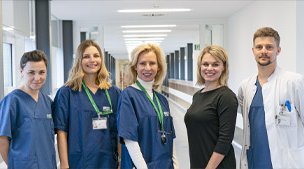
Press conference at the Ministry of Innovation and Technology
On 14 February, the Minister of Innovation and Technology László Palkovics and Dr. Ferenc Krausz held a press conference at the Ministry of Innovation and Technology. Minister Palkovics took the opportunity to congratulate Ferenc Krausz on the recently awarded Wolf Prize for his pioneering work in the field of ultrafast laser science and attosecond physics.
László Palkovics said that the government has for years considered the health economy to be the key to Hungary's economic competitiveness, so it is no coincidence that the Ministry of Innovation and Technology is a committed supporter of the research carried out at the Center for Molecular Fingerprinting.
Ferenc Krausz then presented the CMF's research program, which aims to detect early cancer and other diseases using an innovative method of infrared molecular fingerprinting. Dr. Krausz highlighted that they plan to test blood samples from 15,000 participants over the next 10 years, requiring donors to give blood 1-3 times a year, so that differences between participants and changes within individuals can be tracked.
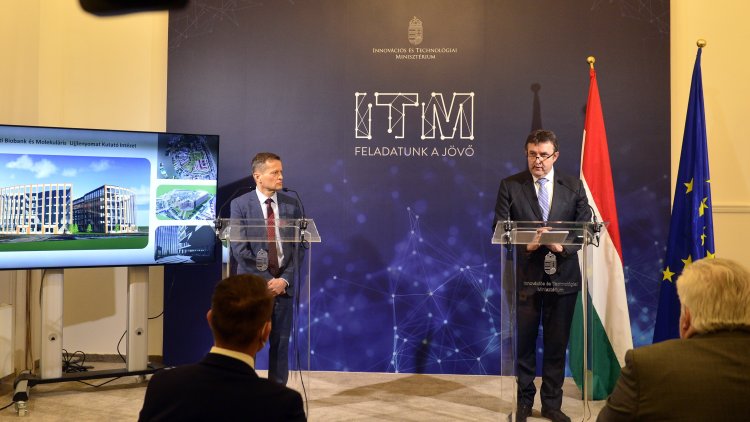
The H4H Program has just reached the 1000th volunteer
The H4H (Health for Hungary - Hungary for Health) project aims to develop an infrared laser-based novel diagnostic tool to provide personalized healthcare to each person’s unique biology and identify diseases before the symptoms arise.
An essential part of the research is the collection of blood samples from healthy individuals voluntarily; therefore, it is important that we reach a wide range of people over the next 10 years. We ask our volunteers to visit us 2-3 times per year. This way, the differences between individuals, as well as changes within the individuals can be described and analyzed.
The collection of blood samples has started in the summer of 2021, and we are proud that we can already announce that the 1000th volunteer has joined the research program. Currently, there are 11 collaborating institutions in Hungary where people can participate but the list of our partners is constantly expanding as we want to bring this research program close to as many people as possible.
We are incredibly grateful for all the volunteers who have trusted us and participated so far. We wish to thank all our colleagues and partners whose hard work and dedication have made this possible, and we look forward to continuing the research together - for advancing the future of healthcare!
For more information and participation details, please visit our www.h4h.hu website.
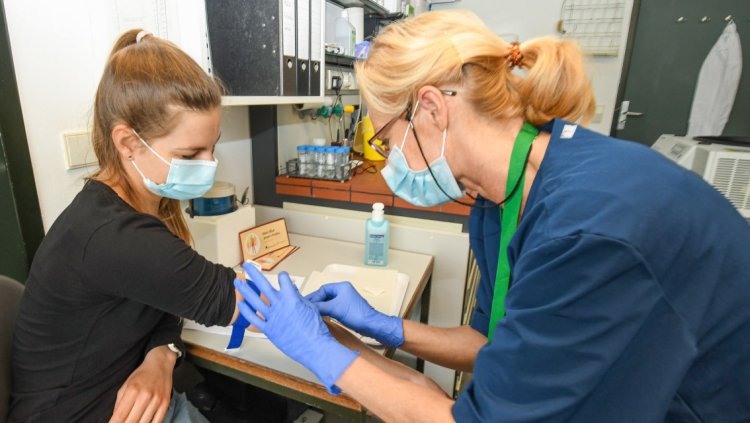
CMF is thrilled to announce that Ferenc Krausz received Wolf prize
Ferenc Krausz is Chair of Experimental Physics - Laser Physics at Ludwig Maximilians University of Munich and Director at the Max Planck Institute of Quantum Optics and Scientific Director at the Center for Molecular Fingerprinting (CMF) in Hungary.
In 2001, Ferenc Krausz and his team at the Vienna University of Technology succeeded for the first time in experimentally generating and measuring single flashes of extreme ultraviolet light that were only attoseconds long (an attosecond is one-billionth of a billionth of a second).
The results marked the beginning of attosecond physics and set a milestone in science. The attosecond light flashes made it possible for the first time to visualize the ultrafast motions of electrons, to photograph them, so to speak. In recent years, Ferenc Krausz and his colleagues have succeeded in making numerous real-time movies of the motion of electrons in molecules and atoms. In addition, these achievements provide a foundation for the analysis of the so-called infrared molecular fingerprints by applying infrared spectroscopy to probing the most complex human matter, tissues. This way, the efforts and results of Ferenc Krausz are not only foundational to the field of physics but also provide new avenues in biomedicine and life sciences, some of which are already on the way to being evaluated.
Since 1978, scientists and artists have been honored for "achievements in the interest of humanity and friendly relations between people (...) without regard to nationality, race, color, religion, sex or political views." The Wolf Prizes in physics and chemistry are considered the most prestigious awards after the Nobel Prize. The Wolf Prize is awarded in Israel.
"I am very honored by the award of the Wolf Prize. I consider it a recognition of what I have achieved together with several outstanding colleagues and collaborators, and an appreciation of the future prospects that ultrafast laser research offers for advancing the frontiers of science and technology," says Ferenc Krausz.
Ferenc Krausz shares the award with his colleagues Paul Corkum of the University of Ottawa and Anne L'Huillier of Lund University. Both are also pioneers in the field of attosecond physics.
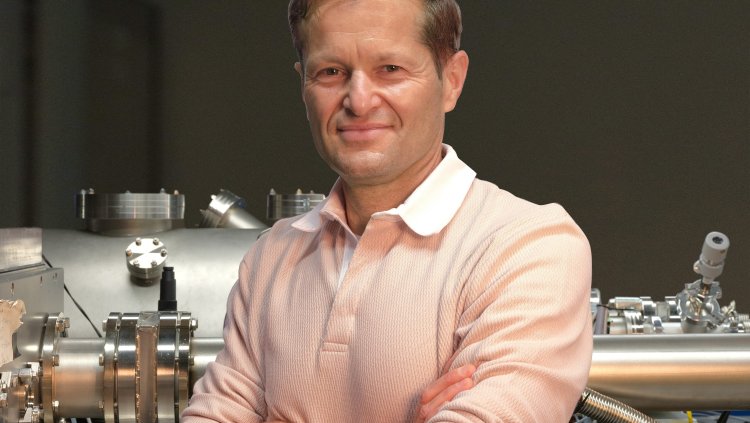
CMF member selected as “Physicist of the Week” by the German Physical Society
As CMF’s Microfluidic Scientist in the BIRD research group, Pushpa develops devices to diagnose disease conditions for various types of cancer using Ultra-fast Infra-Red spectroscopy studies in the range of attosecond. Microfluidics is a versatile and robust tool that requires only a few microliters of patients’ biosamples without compromising data accuracy and precision.
Pushpa is interested in developing point-of-care diagnostic tools for personalized medicine and preventive medicine, drug discovery, and drug delivery. She aims to contribute to powerful yet affordable tools against lethal diseases like cancer.
The dream that Pushpa wants to chase is a Cancer-Free society!
To support her dreams BIRD and CMF join hands.
For more information see here:
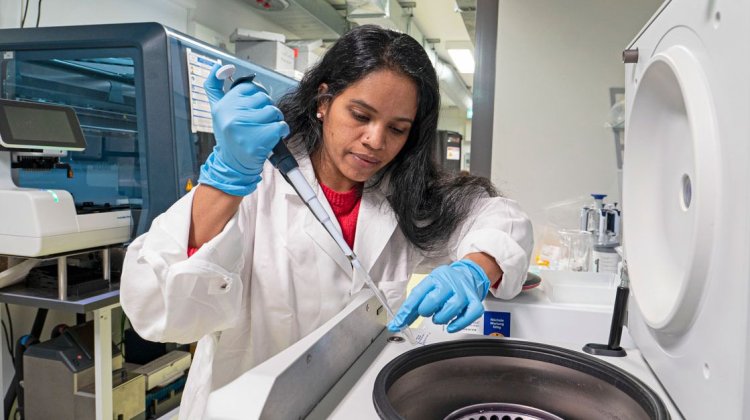
The H4H Program’s brand new website is now live.
The Center for Molecular Fingerprinting has reached a new milestone as the H4H project’s website has been launched. The website provides detailed information about the research program and also invites people to take part and volunteer. Website visitors can find the list of all the collaborating institutions where they can join and participate in our study.
The H4H (Health for Hungary - Hungary for Health) project is part of a cutting-edge nonprofit research program that aims to develop a personalized infrared laser-based novel diagnostic tool for the future of healthcare.
As an essential part of the research is the participation of healthy individuals voluntarily, it is important that we reach a wide range of people and make them aware of the benefits of the H4H project. We believe that this new platform will help educate potential volunteers and with their participation, the H4H project will move further forward. Thus, it can contribute to the development of medicine, with the possibility of creating a reliable health monitoring system improving the quality of life in the future for all of us.
We invite you to take a look at www.h4h.hu.

Our research centre presented itself to EMBL representatives in Szeged
On the 11th of January 2022, the inauguration ceremony of the Incubator House in the Szeged Science Park took place. The building, which is located next to the ELI-ALPS Laser Research Centre in the Science Park, has been renovated and is now the headquarters of the Hungarian Molecular Medicine Centre of Excellence. Representatives of the European Molecular Biology Laboratory also attended the inauguration of the incubator. The Center for Molecular Fingerprinting, as a National Laboratory for Life Sciences Research, was represented by Dr. László Sándor Vastag, our Managing Director.
The ceremony included attendees such as Edith Heard, Director General of EMBL, Plamena Markova, Head of International Relations, and Vladimir Benes, Head of the Genomics Core Facility. The EMBL delegation was joined by Prof. Dr. László Palkovics, the Hungarian Minister for Innovation and Technology, Dr. Christoph Sensen, Director General of the HCEMM, and István Szabó Ph.D., Vice President for Science and International Affairs.
Scientific partnerships and knowledge sharing mark the beginning of an exciting period, especially as EMBL will start its new 5-year scientific program on the 1st of January 2022.
Prof. Edith Heard, Director General of the European Molecular Biology Laboratory (EMBL), said: 'The new program has an ambitious goal: to usher in a new era of life sciences in Europe. Achieving a complete understanding from molecules to entire ecosystems. The focus of research is human health. "We hope that the project will also help to address major societal challenges such as climate change, biodiversity loss, and emerging infectious diseases and cancers. The Programme will integrate life sciences research in the Member States and help them achieve a socio-economic green recovery. The scientific challenges we will address - and the major societal issues we will address - cannot be tackled by any country or discipline alone. The aim of this program is for EMBL to engage with its member countries in an unprecedented way over the next 5 years".
EMBL's network provides a unique opportunity to put European expertise in Hungarian life sciences research into practice. HCEMM, as part of the National Laboratories Programme, brings together the best skills and strengths of Hungarian researchers. The new base in Szeged will help the HCEMM become a regional scientific center for cutting-edge molecular medicine, training, and employment of highly qualified researchers.
"The mission of HCEMM is to carry out research and development on Healthy Ageing based on four pillars: cancer research, metabolic diseases, cardiovascular diseases and infectious diseases. The aim is to develop new diagnostic methods and treatment options that will improve quality of life while reducing healthcare costs. The furnishing of the laboratories and offices will also start within days," said Dr. Christoph Sensen, Director General of the HCEMM.
Our research institute has started discussions with the European Molecular Biology Laboratory to identify possible areas of future collaboration.
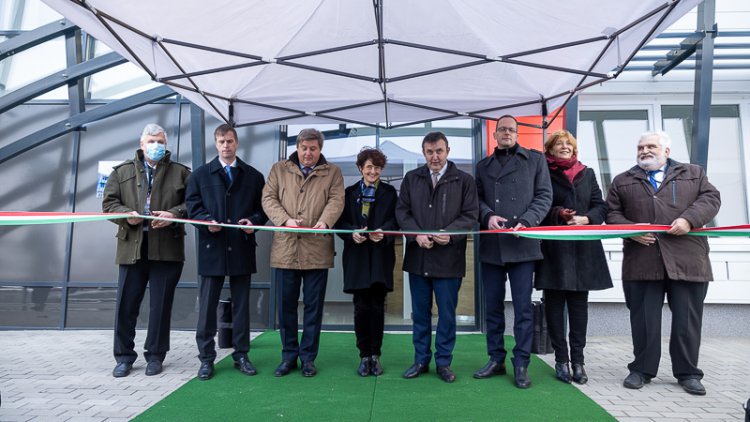
Welcome Dionysios
The CMF research team welcomes Dionysios Potamianos. He just finished his Phd work in Prof. Reinhard Kienberger´s group at the Technical University Munich on femtosecond and attosecond electron dynamics of semiconductor systems. He joined our team as a laser engineer with the focus on infrared fingerprinting technology.
He will help us develop the next-generation instruments for human blood measurements based on a new ultra-stable diode-pumped Cr:ZnS laser platform.
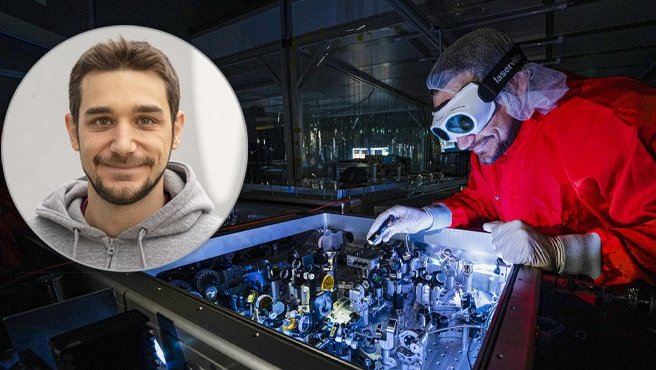
CMF’s promising molecular fingerprint methodology gets a separate chapter in MPQ’s image film
One of the CMF’s main research partner institution: MPQ’s Attoworld group – led by Prof. Dr. Ferenc Krausz – gives home to explore and exploit electron-light interactions as they occur in real-time. Our vision together is creating a breakthrough in the current health monitoring system and shaping the future of healthcare.
The MPQ image film shooting started with an interview with Prof. Dr. Ferenc Krausz (Scientific Director of CMF), in which he answered questions about the scientific content and application areas of attosecond research and talked about motivations and visions. They captured MPQ lab scientists’ daily work, and in the afternoon, they visited the Biolabs and the Lex laboratories, where the science teams develop the new approach of Infrared Molecular Fingerprinting in cooperation with CMF.
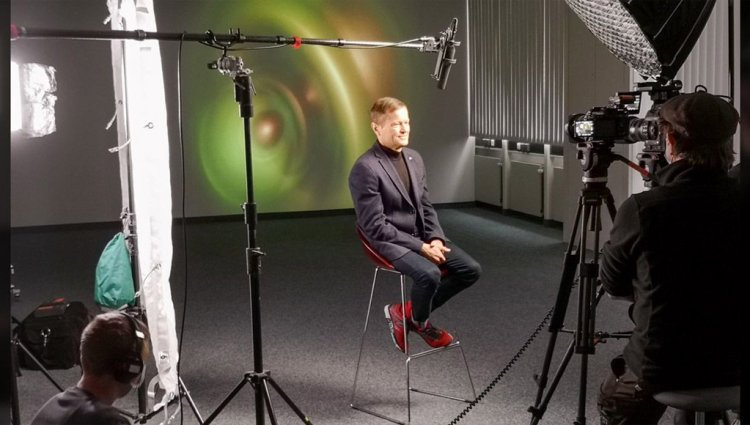
Tracking cancer in your blood
Cancers can grow in numerous places within our bodies and present tremendous threat to our health. But if one could spot cancerous growth early on, the chances to win over it would be higher. Are there ways of achieving this? The team closely collaborating with the Center for Molecular Fingerprinting Research (CMF) from the Laser Physics departments of the Ludwig-Maximilians-University (LMU) in Munich revealed that infrared spectroscopic profiling can be used to pick up molecular traces that solid tumors leave in our bloodstream.
Detecting early and less aggressive cancerous lesions is paramount for having valid medical-treatment options. Besides radiographic tools to visualize tumor tissues within our body, and beyond cutting out tissue biopsies from inner organs for inspection under the microscope, modern diagnostic approaches often focus on non-invasive cancer detection: They analyze bodily fluids and try to capture macroscopically “invisible” molecular changes caused by cancer. In fact, tumors disseminate many aberrant metabolic products and signaling molecules into their surroundings. Likewise, tumors also characteristically interact with adjacent normal cells of a tissue, and later on with our immune cells and blood vessels. These interactions substantially affect the type and amount of many molecules that end up circulating in our bloodstream, even at a time when a tumor is still confined to an organ and not yet metastasizing. However, unambiguously identifying molecules that signify cancer – the holy grail for medical diagnostics and pharma – remains a challenge!
Substantial efforts have been made by the Attoworld research team at the LMU Munich in paving new technological avenues for the most reliable and sensitive detection of molecules in complex liquid matrices. In this context, the BIRD research team (https://www.attoworld.de/bird.html) just published a paper in eLife ( DOI: 10.7554/eLife.68758 ) where they flowed a tiny volume of a blood sample through a cuvette, shined infrared light through it, and quantified the complex changes in the light-wave patterns coming from the blood sample as a function of the identity and number of the hundreds of thousands of different molecules dissolved therein. Extracting information by using machine learning algorithms allows determining a signature that is so highly characteristic of an individual’s blood sample that the signature can be referred to as a “molecular fingerprint”. The BIRD team’s earlier work already showed that such infrared molecular fingerprints were highly reproducible over repeated blood draws from an individual (Huber et al., Nat. Communications 2021, PMCID: PMC7940620).
The size of the problem in tracing disease like cancer by infrared molecular fingerprinting now becomes immediately obvious: One has to move to the population level and explore hundreds of individuals to be in the position to extract the difference between the average healthy fingerprint and the average disease fingerprint. How does it work in real life? In collaboration with medical doctors from LMU clinics, the BIRD team set up a matched case-control clinical study and performed comparative infrared molecular fingerprinting on samples from patients with independently diagnosed lung, prostate, breast, or bladder carcinomas. And indeed, infrared fingerprinting of blood was surprisingly robust and correctly detected the cancer state. Excitingly, infrared fingerprints could be utilized, not only for detecting cancer but also for distinguishing between different cancer types, indicating that each had triggered specific molecular alterations.
Could the approach move into the clinics one day? While still far from being a method that patients can benefit from in medical clinics, the published study substantiates the expectation that, in the future, infrared fingerprinting may become useful for aiding cancer diagnosis or even for cancer screening of low-grade cancers that would go unnoticed using current cancer tests. In particular, infrared fingerprinting may be propelled to yet another level soon. Especially when ultrafast light sources and high-precision electric-field-based metrologies from the Attoworld’s research will come into play.
The path can be seen, and the quest continues.

A snapshot of blood serum composition on the cover
With their Research Article published in “Angewandte Chemie Int. Ed.”, Mihaela Žigman et al. made it on the cover of the 2021-60/31 June 2021 issue. The picture shows a snapshot of blood serum composition that reflects the health state of an individual.
It can be obtained using infrared spectroscopy in a simple and inexpensive manner, but the molecular nature of the disease-related changes therein remains poorly understood. In their article the researchers report using proteomics to reveal a set of proteins that contribute the most to infrared absorption of blood serum and show that they create a distinct signature of lung cancer. The cover image was designed by the corresponding authors and created by Dennis Luck.
Original publication:
Molecular Origin of Blood-Based Infrared Spectroscopic Fingerprints
L. Voronina, C. Leonardo, J. Mueller-Reif, P. Geyer, M. Huber, M. Trubetskov, K. Kepesidis, J. Behr, M. Mann, F. Krausz, M. Žigman
Angewandte Chemie 60, 17060 (2021)
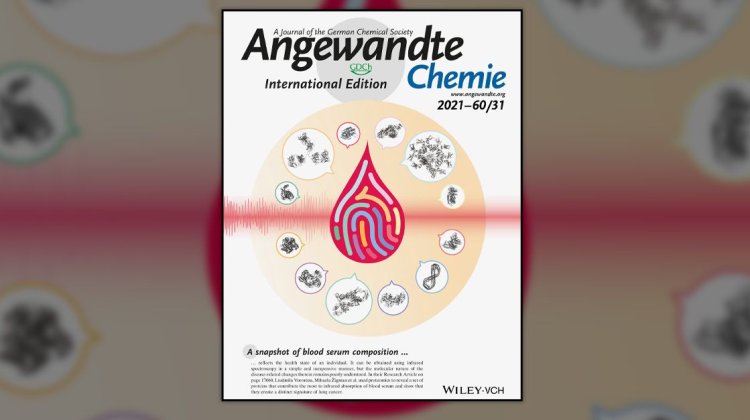
The doors of future health monitoring study at CMF just opened!
The “Center for Molecular Fingerprinting” (CMF) in Hungary has achieved another milestone and collected its first blood samples for its future research in health monitoring in the course of the medical study “Health for Hungary” (H4H).
The future of healthcare is at a turning point - modern diagnostic techniques are moving towards a preventive and personalized diagnostic approach, rather than a treatment-after-detection used this far. The overriding aim at CMF is thus to detect severe health conditions and diseases well before symptoms develop - to be able to treat them better. Analysis of the composition of blood samples with ultrashort laser pulses could provide the opportunity for personalised health monitoring by repeated sampling of the same person over time. And this is where “Center for Molecular Fingerprinting“ (CMF) steps in:
July 27th, 2021, marked an important milestone for the research activities of the CMF in Hungary. As part of the "Health4Hungary" (H4H) study, that is aimed to establish infrared fingerprinting for health monitoring, the first blood samples for innovative early detection of diseases were successfully collected for CMF in a first kick-off: The doors for this nation-wide research program just opened at the end of July at the medical cooperation partner “Vita Verum Medical Bt.” (at Székesfehérvár near Budapest), being the initial site in a series of further ones to be joining soon.
After intensive training of the medical staff and coaching regarding the data protection guidelines by the CMF team, the first volunteers were welcomed for blood collection. The H4H took off is the tipping point for the large study to happen across Hungary!
What is this research and study good for? CMF's goal is to develop new laser-based tools for monitoring human health in a new way, not possible before. How? By analyzing blood samples in an innovative process using ultrashort laser flashes. This unique and complex technique has its origin in the attoworld research group of Prof. Ferenc Krausz in Munich. The application of how to use these laser pulses to probe human health was established within the team around Dr. Mihaela Zigman and will be further developed in collaboration with CMF. The goal of the H4H program is to recruit individuals as volunteers from broad segments of the Hungarian population - to facilitate the development of this research and to finally develop a new possibility to track and monitor development of diseases.
The project is planned for several years and aimed at involving 10,000+ individuals at numerous sites across Hungary. The multiple medical centers over the country will not only provide convenient access for anyone wishing to participate. They also ensure that samples are taken from different geographical areas of Hungary to ideally cover a broad spectrum of the Hungarian population.
After data collection and blood sampling, the tubes are pseudonymously transmitted to the research group. In this way, it is not possible for the researchers to personally identify the test person due to data protection regulations. In the next step, the blood samples are stored under special cooling conditions for laser-based data analysis and subsequently evaluated. During the blood donation for research purposes an additional tube is obtained, providing the volunteer with regular lab results, not only blood count but also blood chemistry results.
Furthermore, contributing to this research program will be making an immensely important and far-sighted contribution for our population and our relatives, our children, and our grandchildren, which will hopefully all help to detect severe diseases at an early stage in the future, so that optimal therapy may become possible before the disease can fully develop!
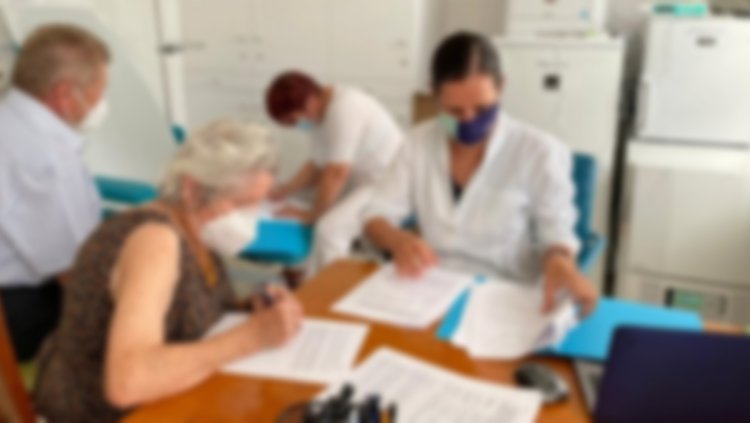
The joint patent application of the CMF with the LMU Munich and the Max-Planck Institute for Quantum Optics on Tailored Infrared Amplification with Quantum Cascade Lasers
The core technology at CMF for detecting diseases by their molecular fingerprints in a blood sample is field-resolved infrared spectroscopy. It relies on the generation of extremely short infrared pulses by nonlinear laser technology to excite the molecules in the sample, followed by recording the ringing of the molecular response.
The sensitivity for disease detection depends on the brightness of the infrared laser pulses and their spectral information content, i.e., on how many different molecular vibrations the infrared pulses can excite simultaneously. Scaling the brightness and spectral content currently requires an ever increasing in complexity and size of the laser systems. In addition, conventional scaling approaches ultimately reach the fundamental limits of the involved conversion processes.
In a collaboration between the CMF, the LMU Munich, and the Max-Planck Institute for Quantum Optics Dr. Shizhen Qu, Dr. Kafai Mak, Dr. Alexander Weigel, and Prof. Ferenc Krausz have now proposed the elegant solution to amplify the infrared pulses with quantum cascade lasers (QCLs). QCLs are compact on-the-chip laser devices, which can reach Watt-scale infrared optical output with direct electrical power supply – much more than typically achievable with nonlinear techniques. The core of the invention is to send the ultrashort infrared pulses into a combination of QCLs to boost them to previously unachievable power levels. Conveniently, the emission characteristics of QCLs can be tailored by their semiconductor layer structure to specifically amplify spectral components that excite characteristic fingerprint signatures in the blood samples. By selectively enhancing only those parts of the pulse that contribute to the disease-specific fingerprint signatures with a combination of QCLs we expect to reach new levels of sensitivity. With appropriate timing, also amplification of the pure molecular fingerprint signal itself is conceivable.
This first joint patent application witnesses the successful collaboration of the three institutions on the way towards highly sensitive blood-based disease detection and health monitoring.
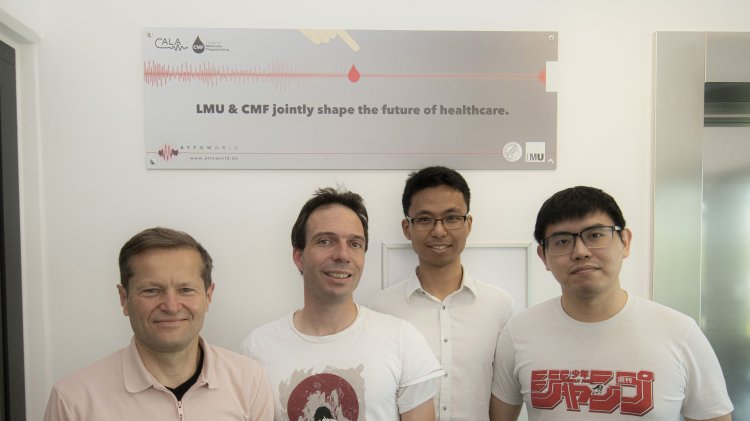
A drop in the ocean
Thousands of researchers are seeking ways to capture human health within a simple probe. Why? Every person is unique – in the personality as well as in terms of health. And the task of defining the healthy state at a populational level is just colossal. In the face of this, it is crucial to detect aberrations in health as soon as only possible, raising the alarm that a disease is sneaking into one’s body. Many diseases could be better coped with if we were alarmed earlier, as they only start developing. Especially cancer. This is where less invasive ways of disease detection come into play.
In a very inter-disciplinary team at the laser physics department of the LMU Munich, we believe to have made a step in this direction: We analyzed a fluid that connects all the organs – blood. The idea is familiar to anyone from medical check-ups, and it has recently been used for profiling with modern omics techniques. In our case, however, we exposed tiny amounts of blood to infrared light and captured the vibrations originating from the soluble biomolecules. In collaborative work with medical doctors from the LMU Comprehensive Pneumology Center, we set up a proof-of-principle clinical study to collect blood of individuals that were definitely known to have lung cancer, and in parallel from generally healthy, comparable individuals. We measured their blood samples with infrared spectroscopy. And finally - with quite high certainty - we succeeded to tell apart whether a person had lung cancer or not. From a mere drop of blood.
Eureka? Well, we want to go even further. While infrared fingerprints may distinguish lung cancer, they do not yet inform us about the individual blood components that make up the difference. Nevertheless, it would be good to know their identity to be able to further improve the method. This is what we demonstrated in a new study just published in Angewandte Chemie (DOI: 10.1002/anie.202103272). It is all about a combination of two techniques that are usually applied separately: mass spectrometry and infrared spectroscopy. The aim was to decode the actual chemical changes behind the previously “black box” infrared fingerprints of lung cancer. Now, with mass spectrometry of blood samples performed at the Max Planck Institute of Biochemistry in Munich, we identified a set of 12 proteins that account for the spectral signature of lung cancer, where early diagnostic markers are currently missing. All of these proteins were known since a long time. Now - like old dogs playing new tricks - the combinatorial protein signature that we defined turns a new page in diagnostic efforts. And this signature can be measured in a matter of minutes using infrared light!
So are we now one step closer to capturing disease and defining health? Certainly so. Especially as laser scientists at our department are engineering new ways of delivering ever shorter and more precise pulses of light for spectroscopic investigations. Metaphorically, this is like a magnifying lens that allows us to inspect the molecular zoo in our blood at once – in a snapshot. Finally, the results are of broader relevance for many disciplines, as one may generalize our findings to detection of other diseases that leave their traces in blood.
Yet, while we are working on new advances in capturing human health by shining light through drops of blood, we are bearing in mind the notion of Isaak Newton: “What we know is a drop, what we don’t know is an ocean.”.
Mihaela Zigman
Original article:
Angew Chem Int Ed Engl
Molecular Origin of Blood-based Infrared Spctroscopic Fingerprints
Liudmila Voronina, Cristina Leonardo, Johannes B Mueller-Reif, Philipp E Geyer, Marinus Huber, Michael Trubetskov, Kosmas V Kepesidis, Jürgen Behr, Matthias Mann, Krausz Ferenc, Mihaela Žigman
PMID: 33881784
DOI: 10.1002 / anie.202103272
https://onlinelibrary.wiley.com/doi/10.1002/anie.202103272
https://onlinelibrary.wiley.com/doi/10.1002/ange.202107126
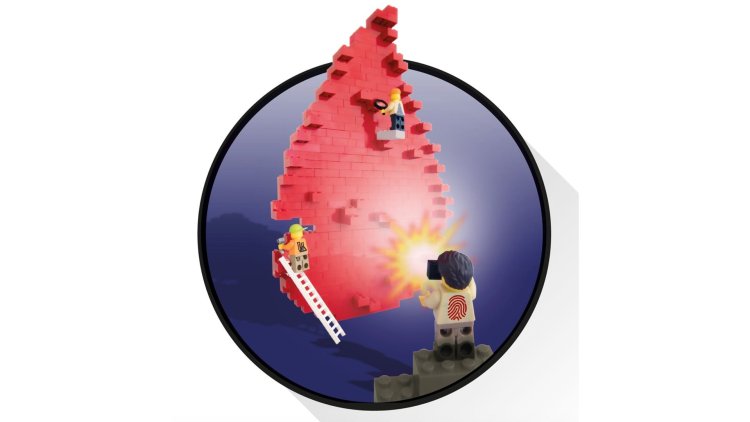
“Electrons for life” went live in Vienna
After a very long pause due to the pandemic, the chance to listen to a lecture and talk to Ferenc Krausz in person took place just on May 28th in Vienna. It was a special occasion. Not only in a city significant for attoscience but also special to the Hungarian-Austrian scientist Ferenc Krausz who worked there over many years. The Austrian Academy of Sciences (OeAW) held its Ceremonial Congress of 2021 with renowned scientists lead by Anton Zeilinger, president of the OeAW, as well as Austrian president Alexander Van der Bellen, welcoming Ferenc Krausz as the keynote speaker.
Anyone that would like to watch the ceremonial presentation, seeing the results of Ferenc Krausz and his team from the CMF, LMU and MPQ, here you get the chance to see the video: https://youtu.be/4dQn4fe33hc
In a wake of this impulsive lecture, the main Austrian broadcasting house (ORF) held an interview with Ferenc Krausz. And right here you have the chance to listen and read on the interview with journalist Robert Czepel and learn about what happened in the cellar laboratory of the TU Vienna about two decades ago: https://science.orf.at/stories/3206849/
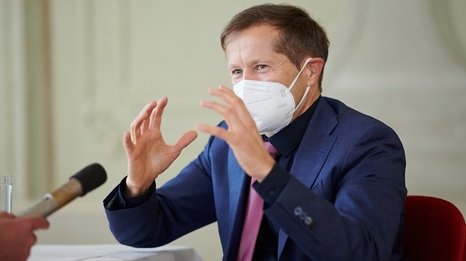
Sample storage at its best
CMF’s strategic partner, the Ludwig-Maximilians-University (LMU) in Munich, Germany, just installed an automated biobanking system for sample storage at temperatures below minus 150°C. What is this good for? Under these very low temperatures - so called “cryogenic” conditions in the atmosphere above liquid nitrogen - human samples, such as blood plasma or actually any biological tissues, can be kept for several years, decades without sample deterioration.
It assures that valuable human materials collected in frame of clinical studies can be used in long term and thus enables researchers to analyze these with molecular fingerprinting techniques most efficiently. Such an automated cryogenic system is made of large tightly sealed tank that is capable to store up to 60,000 samples. The system is further equipped with a robotic arm that can pick individual tubes automatically, such that the samples are kept and handled well below minus 100 °C at all times.
This installation has a direct impact for the future of the joint CMF-LMU research aims. On the one hand the two institutions will be conducting joint clinical studies. On the other, LMU biobanking system also serves as a test case for the CMF’s envisioned own biorepository, to be established in Budapest.
Thus, CMF is getting familiar with the best way to store most valuable biological materials for the years of research to come!
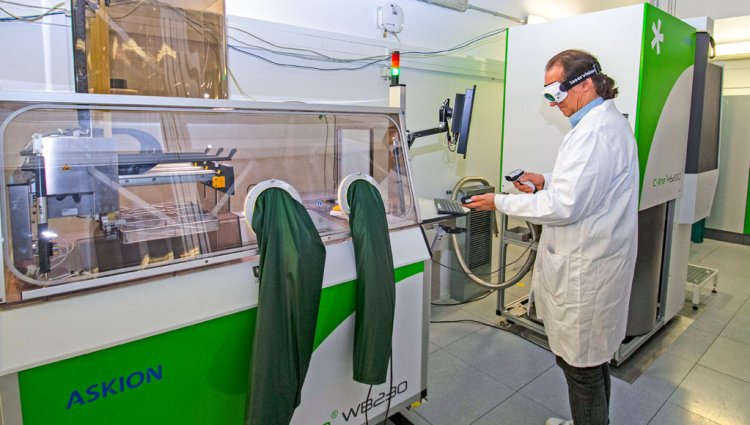
Field-resolved infrared spectroscopy of biological systems
In cooperation between the Laboratory of Attosecond Physics at the Max Planck Institute of Quantum Optics and the Centre for Advanced Laser Applications of the Ludwig-Maximilians-Universität München, the King Saud University Riad and the Center for Molecular Fingerprinting (Budapest, Hungary), we have developed a molecular spectroscopy technique that overcomes long-standing limitations of traditional techniques, like Fourier-transform infrared spectroscopy, as described in our recent publication.
A powerful femtosecond laser delivers 28 million pulses per second, with highly repeatable waveforms, comprising merely a few infrared-electric-field oscillations. Transmitting these pulses through a complex, molecular sample synchronously excites infrared-active vibrations of molecular bonds, each at its own eigenfrequency. The signals emitted by the vibrationally-excited molecules in the wake of the impulsive excitation coherently add up to a ‘molecular fingerprint’ characteristic of the sample’s molecular composition.
In contrast to traditional spectroscopies, where the entire response of the sample to an infrared excitation hits the detector(s), in field-resolved spectroscopy sub-optical-cycle portions of the time-domain fingerprint field are sequentially carved out by means of nonlinear optics. This dramatically reduces any infrared background on the measured signals, including the noise originating from the excitation and thermal background. This conceptional advance results in an unprecedented detection sensitivity and dynamic range.
We have also demonstrated first biological applications that have so far been beyond the reach of infrared vibrational spectroscopies. These applications include first high-signal-to-noise ratio infrared transmission measurements of living biological tissue and fingerprinting of liquid biopsies with sub-µg/ml sensitivity. Thus, field-resolved spectroscopy promises improved molecular sensitivity and molecular coverage for probing complex, real-world biological and medical settings.
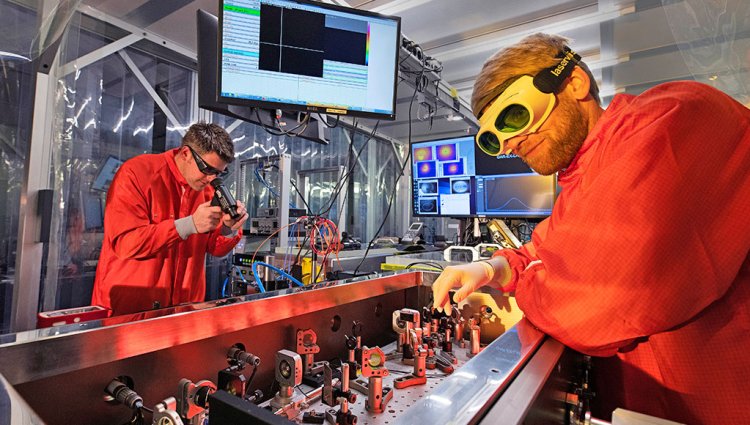
Prof. Ferenc Krausz has recieved the honorary membership of the Roland Eötvös Physical Society
Prof. Ferenc Krausz has recieved the honorary membership of the Roland Eötvös Physical Society, Budapest. After receiving the membership the laser physicist of the Ludwig-Maximilians University München and the Max-Planck-Institute of Quantum Optics held an lecture about how attosecond science technologies can in the future contribute to a new way of finding molecules in human biofluids like blood.
This may path the way for medical applications to detect diseases by analyzing so called molecular fingerprints with the help of strong laser light pulses.
